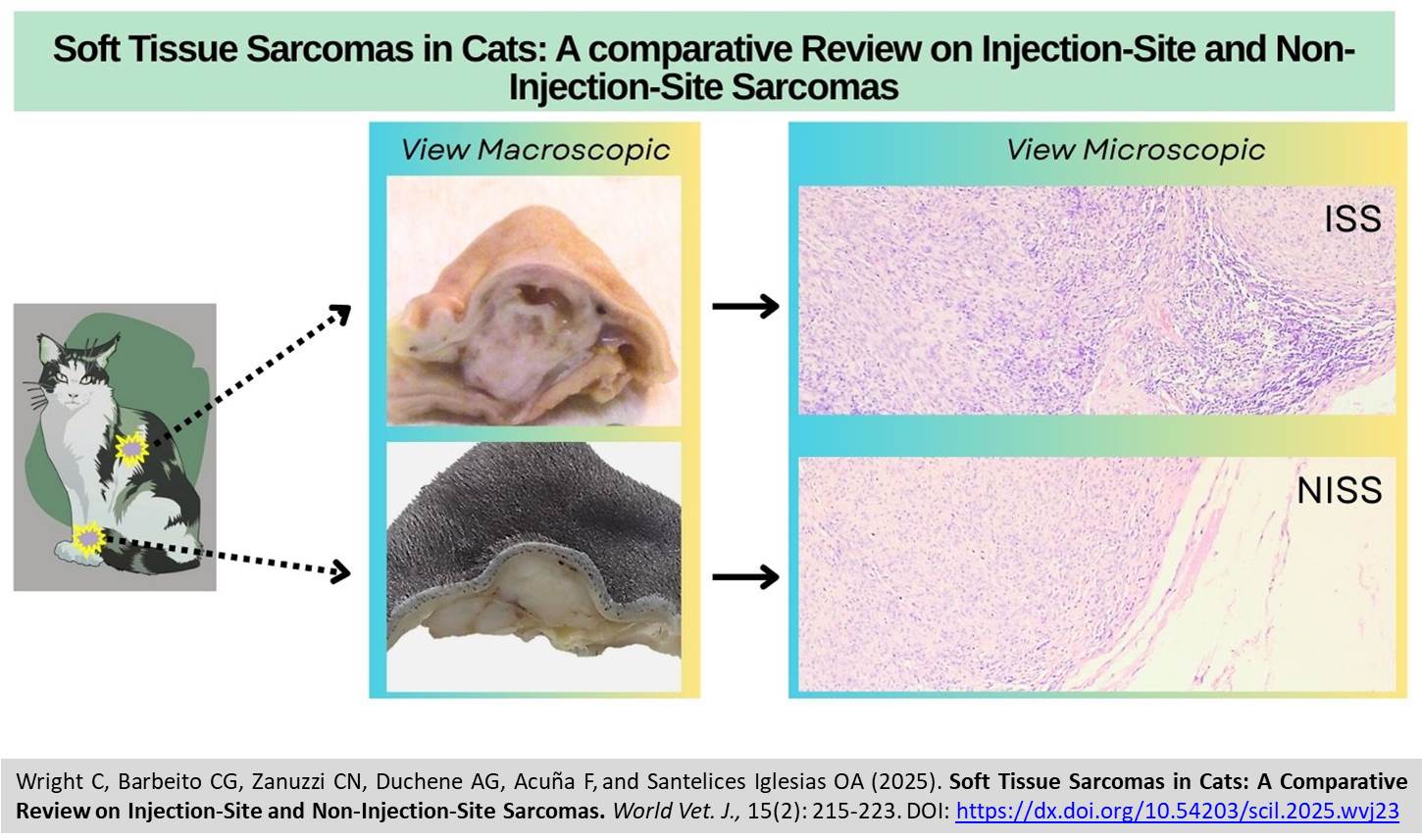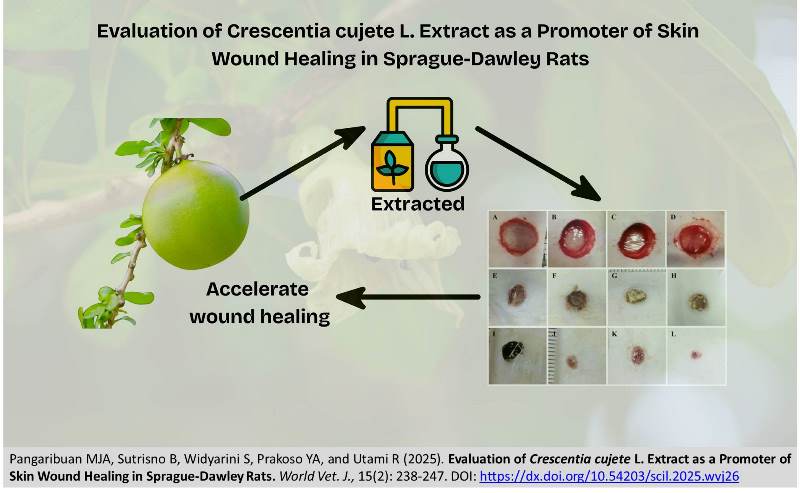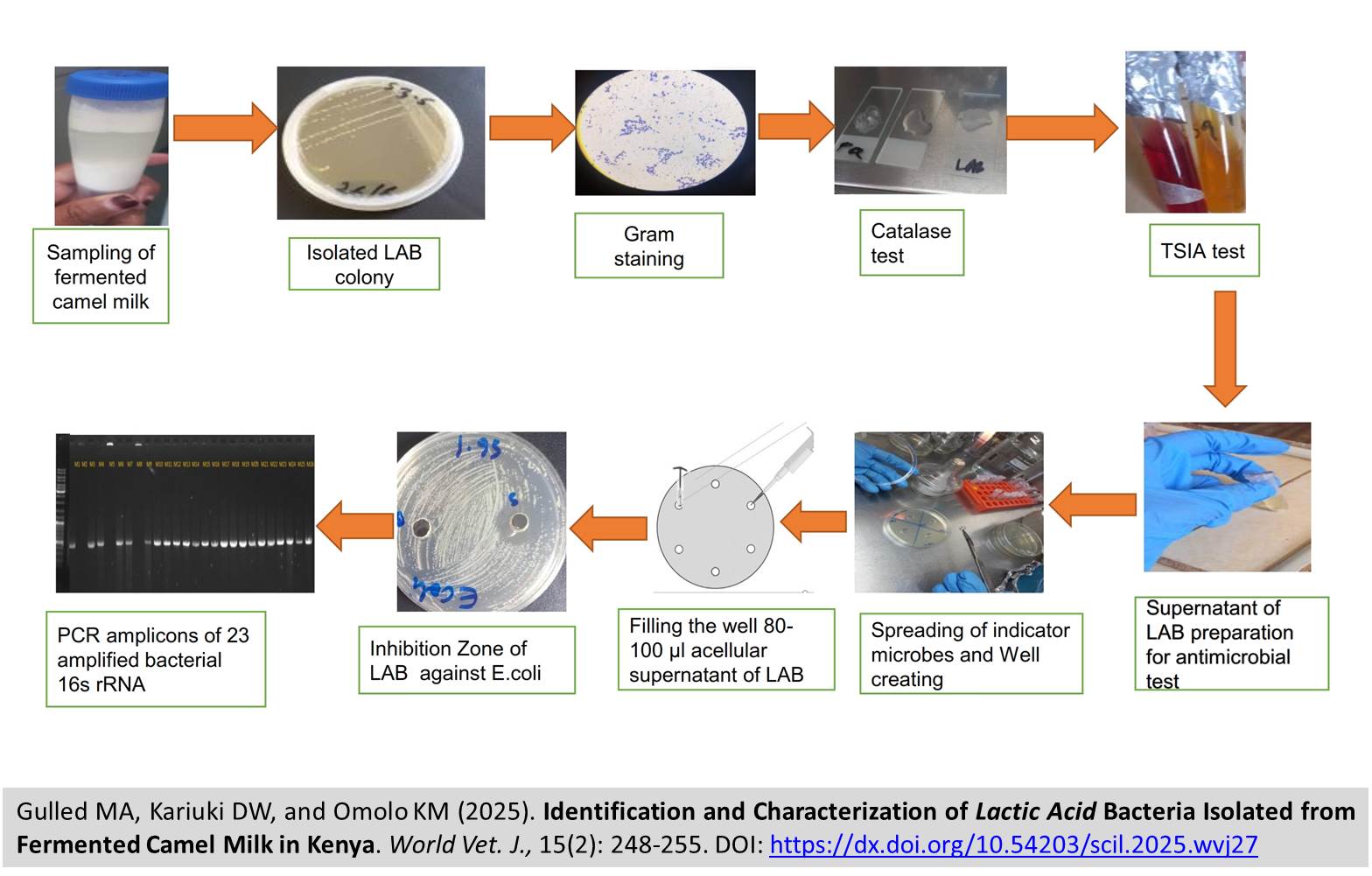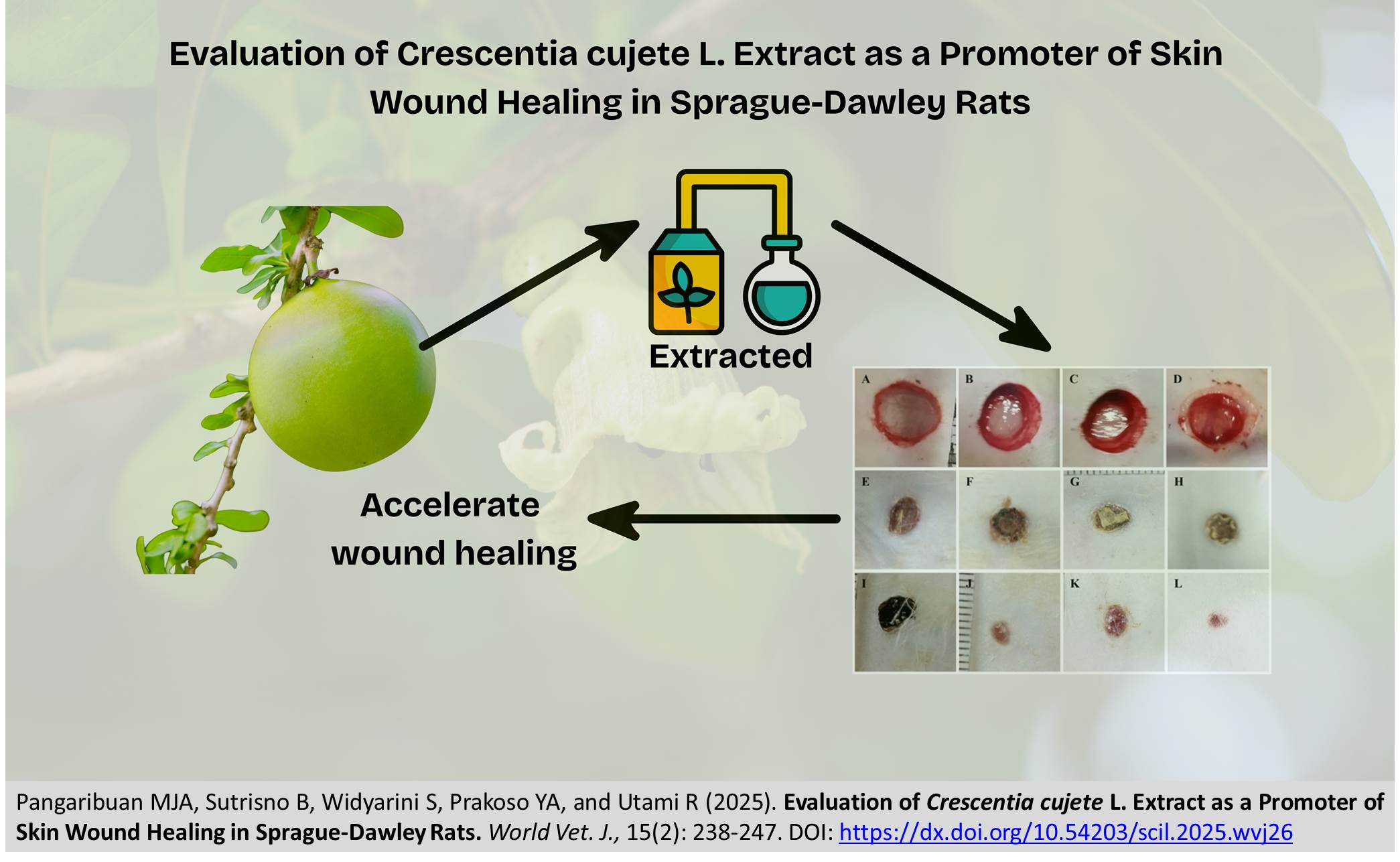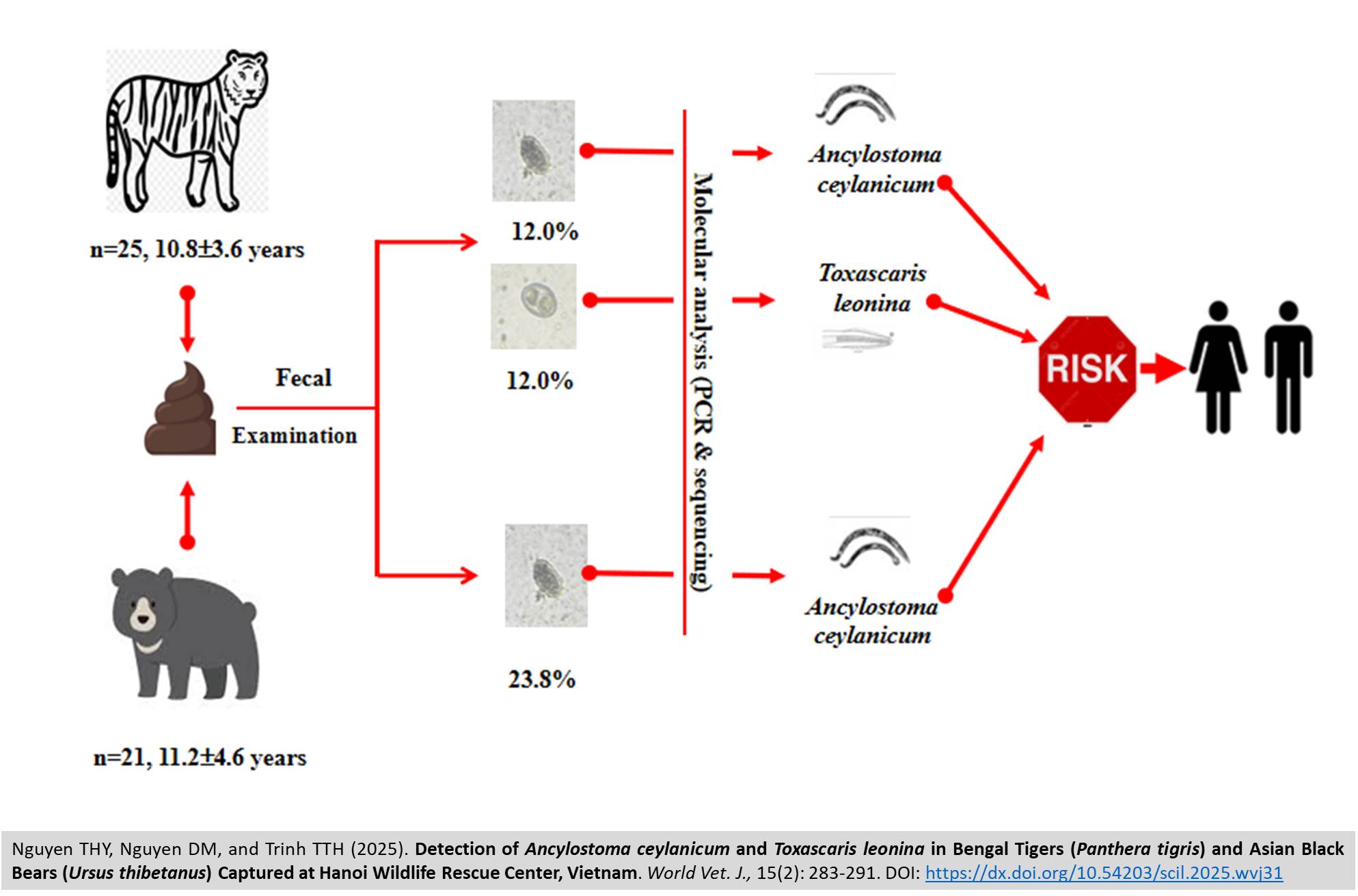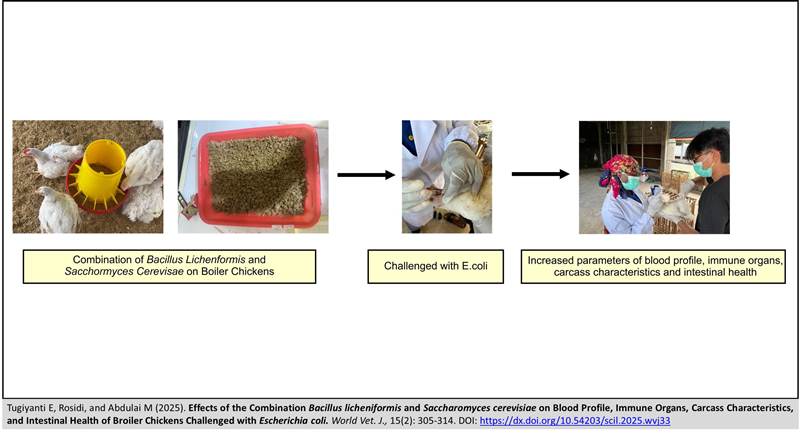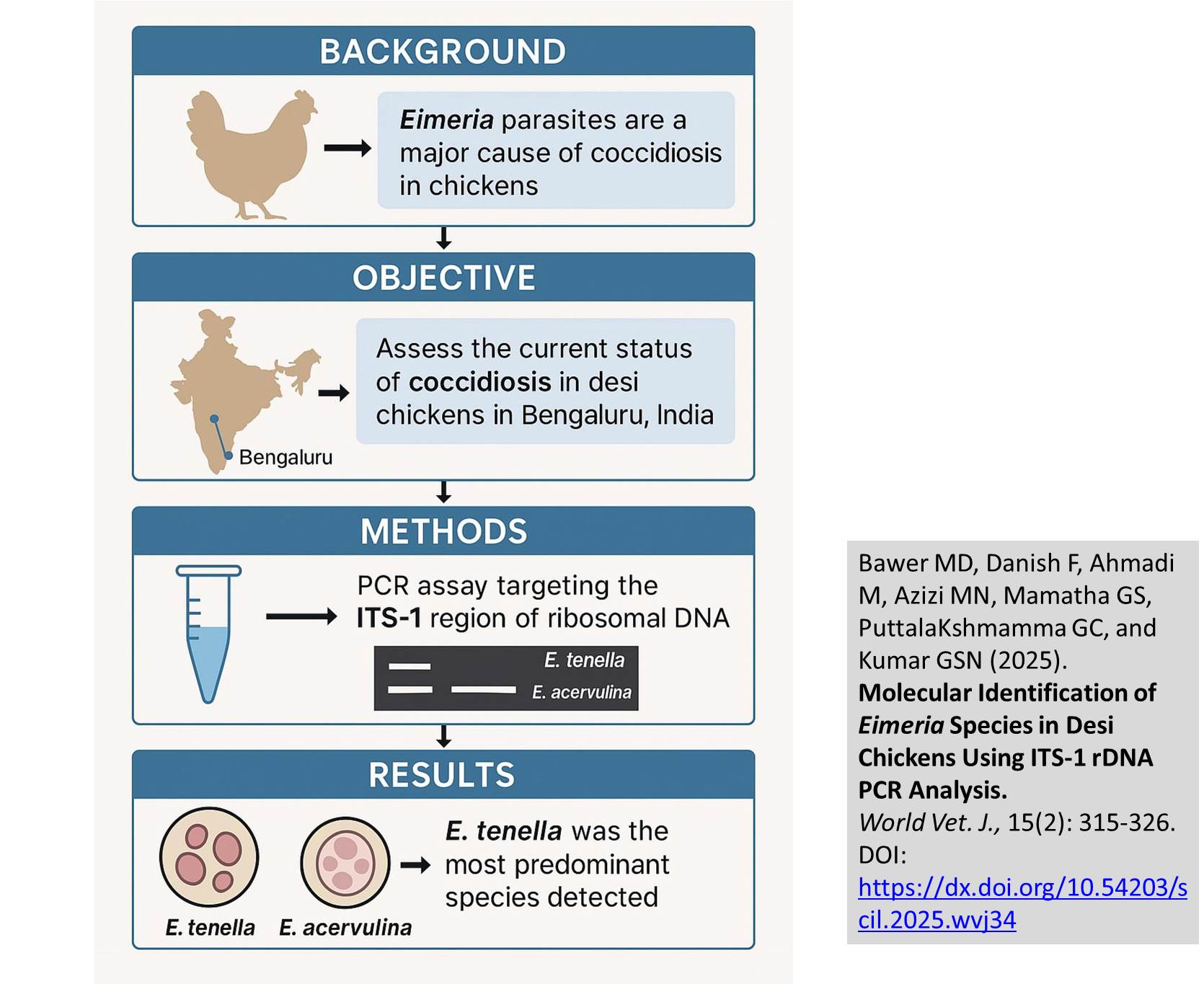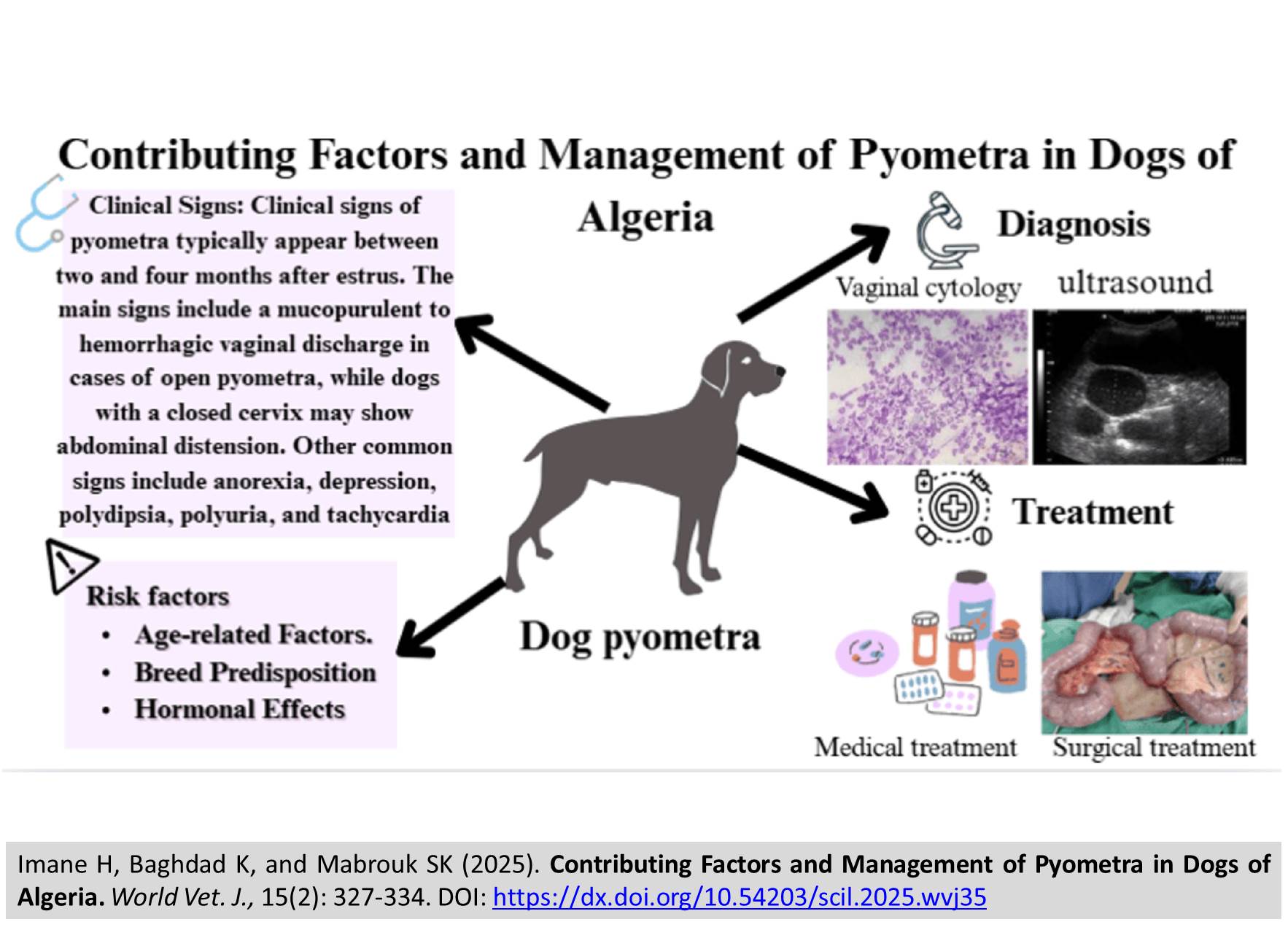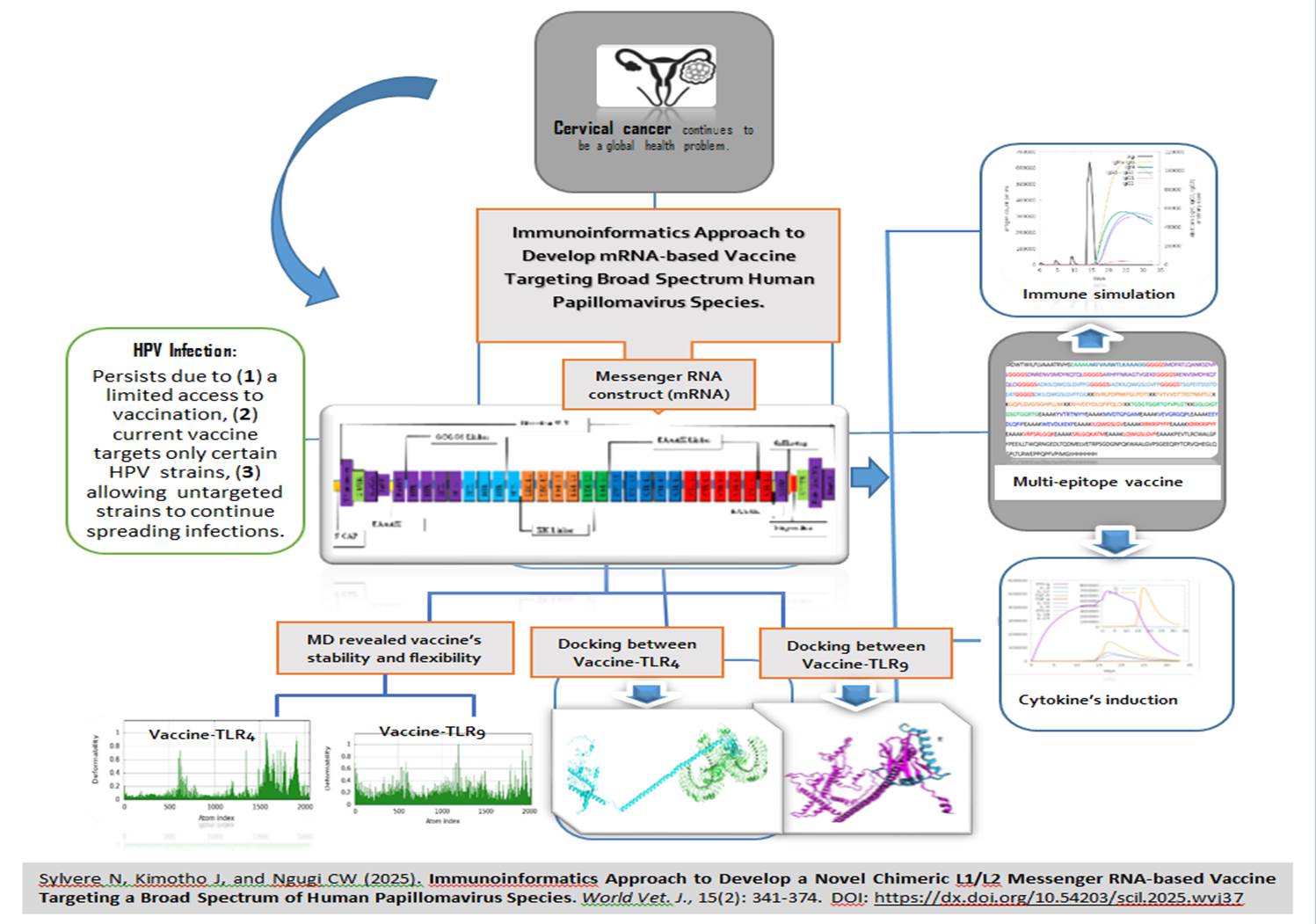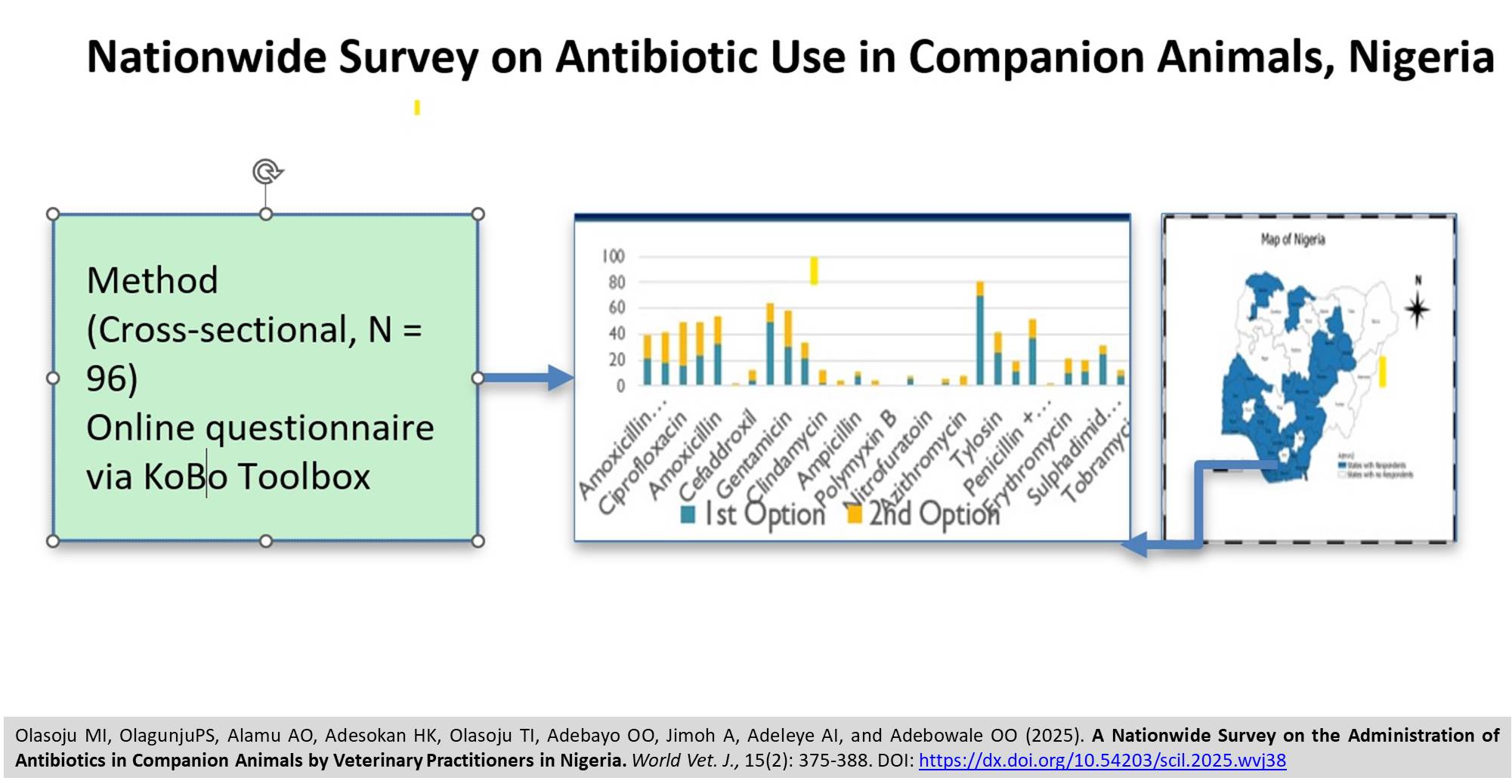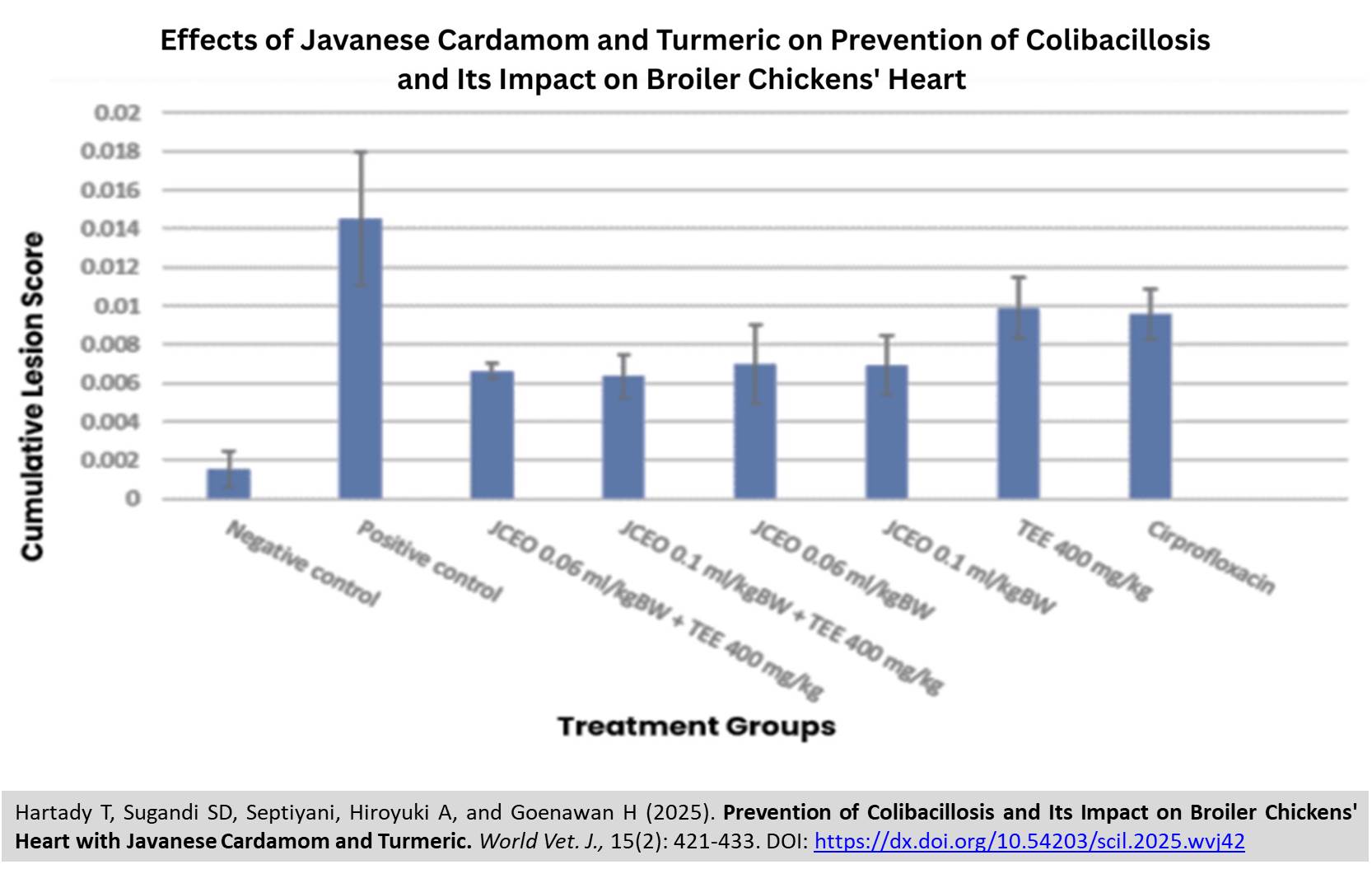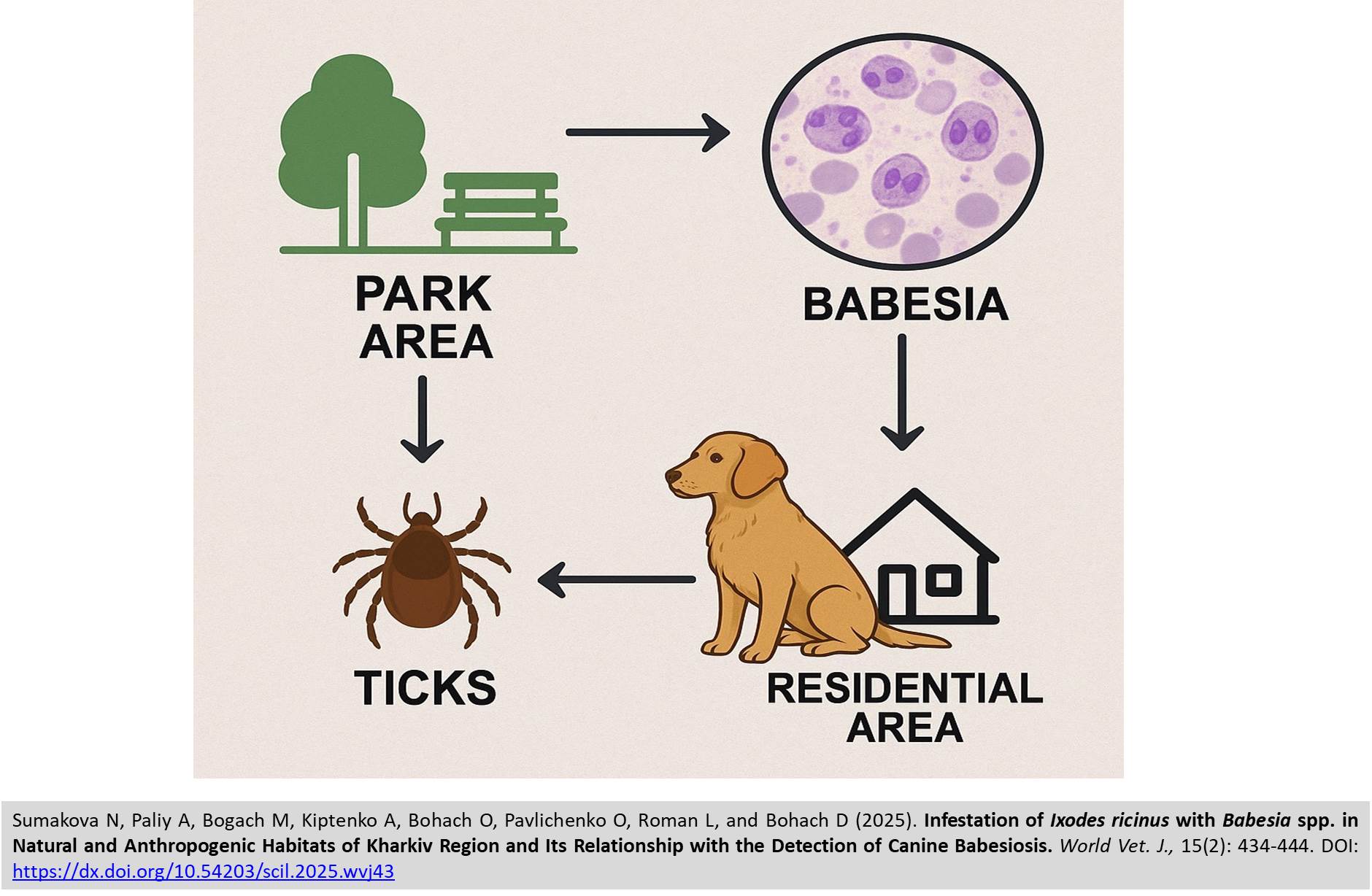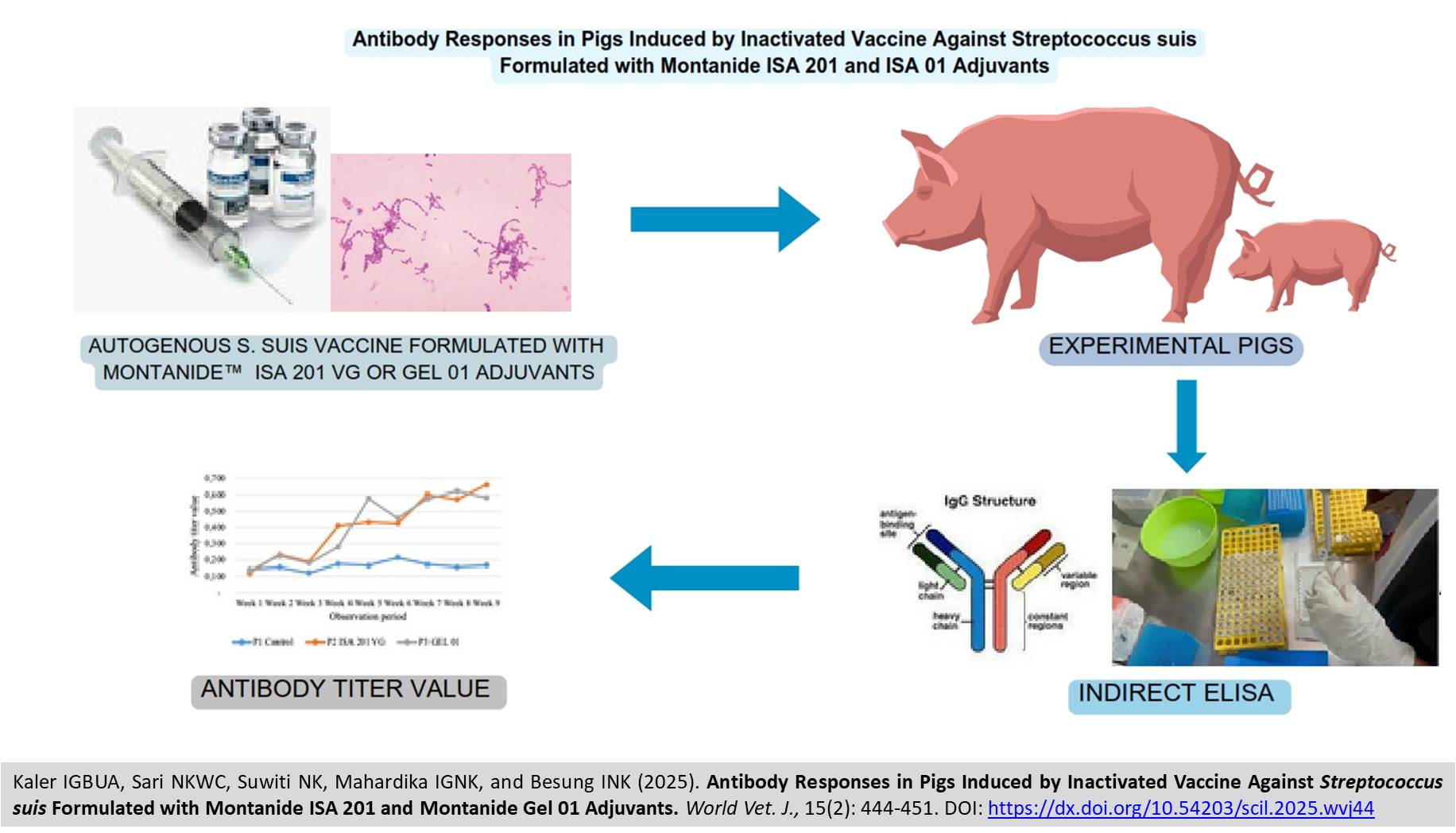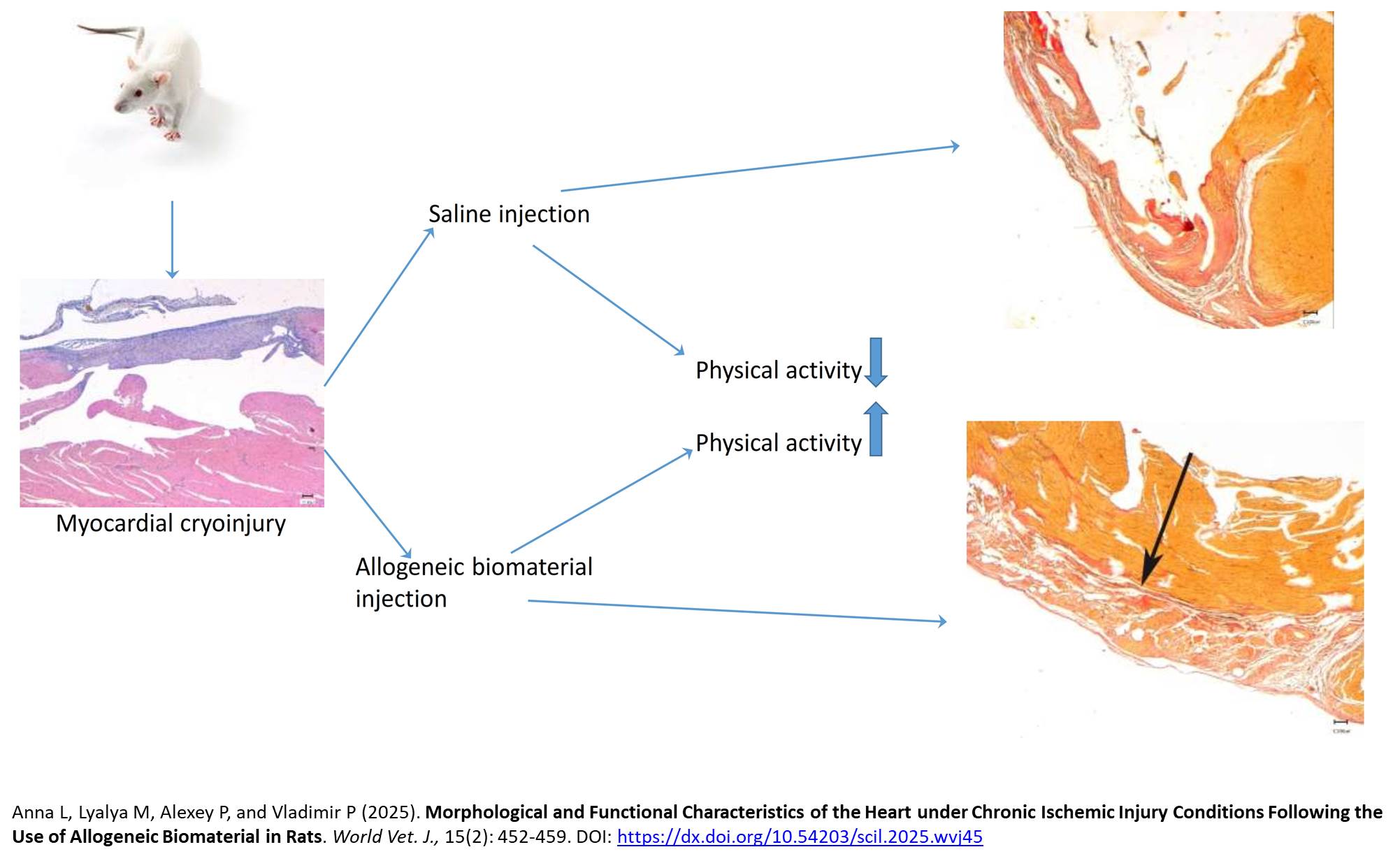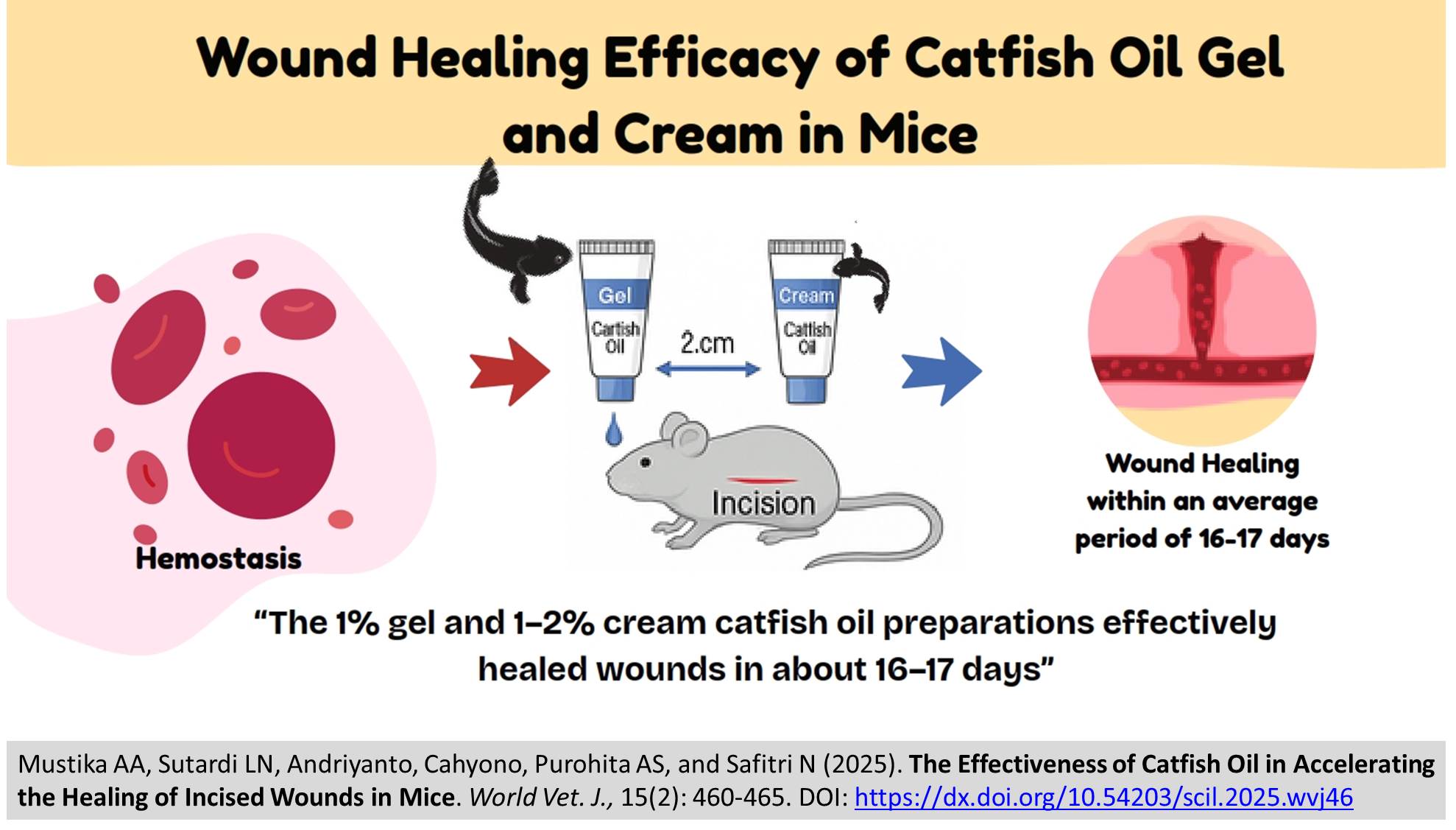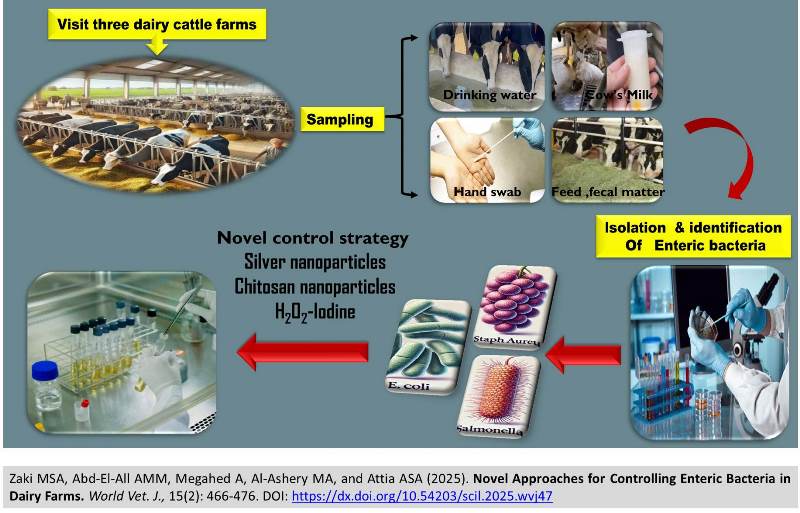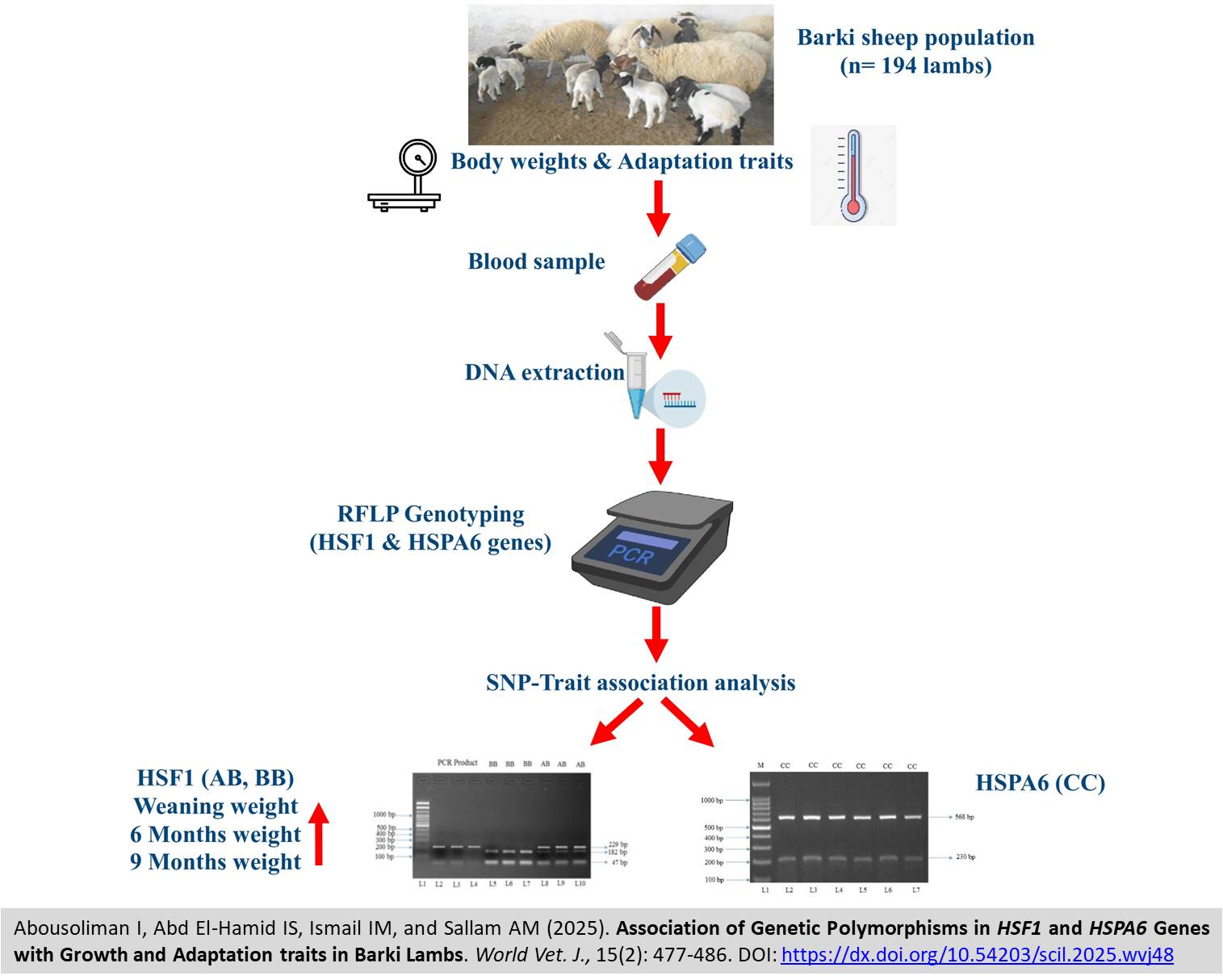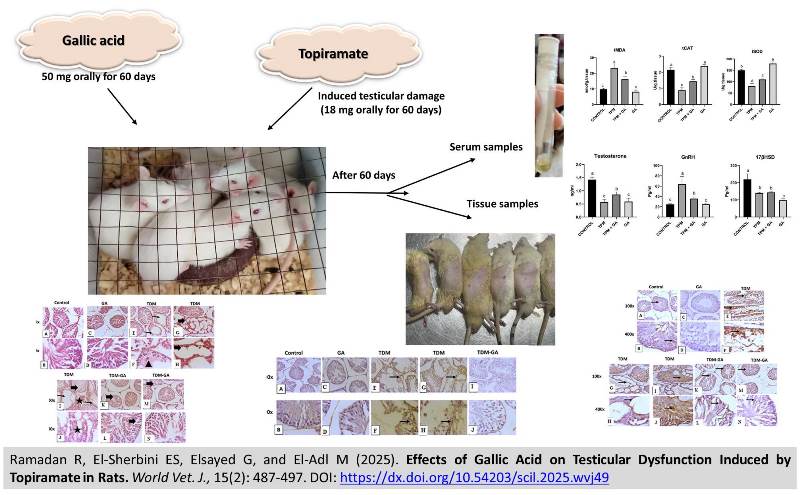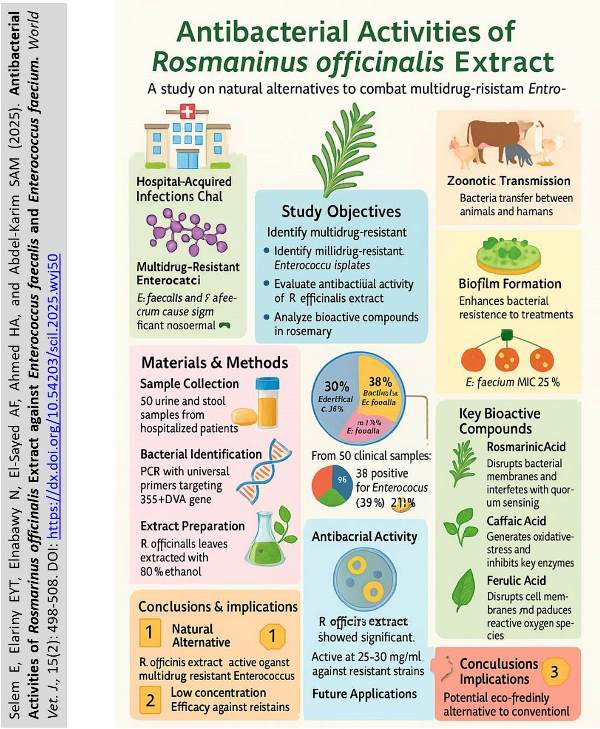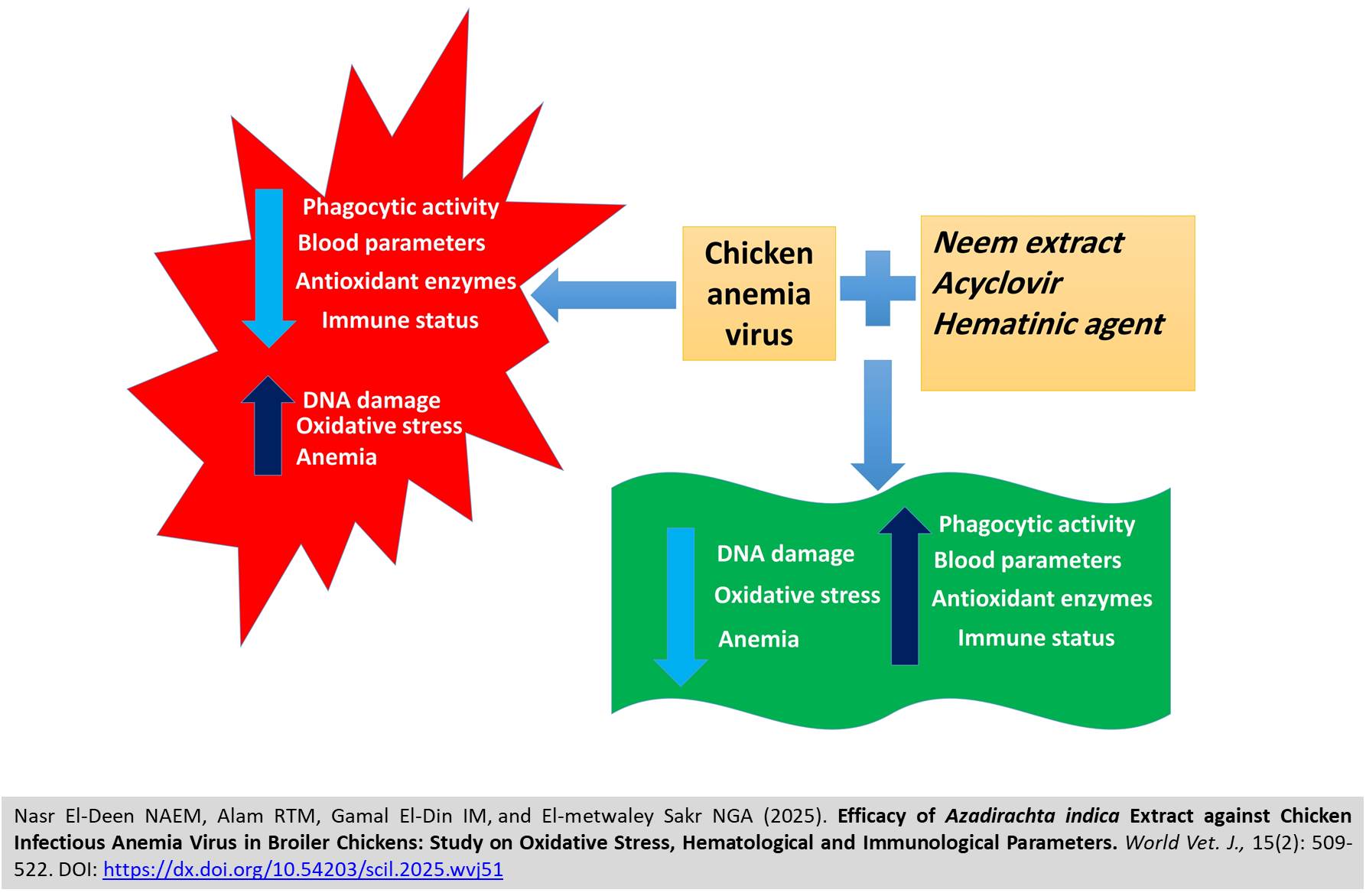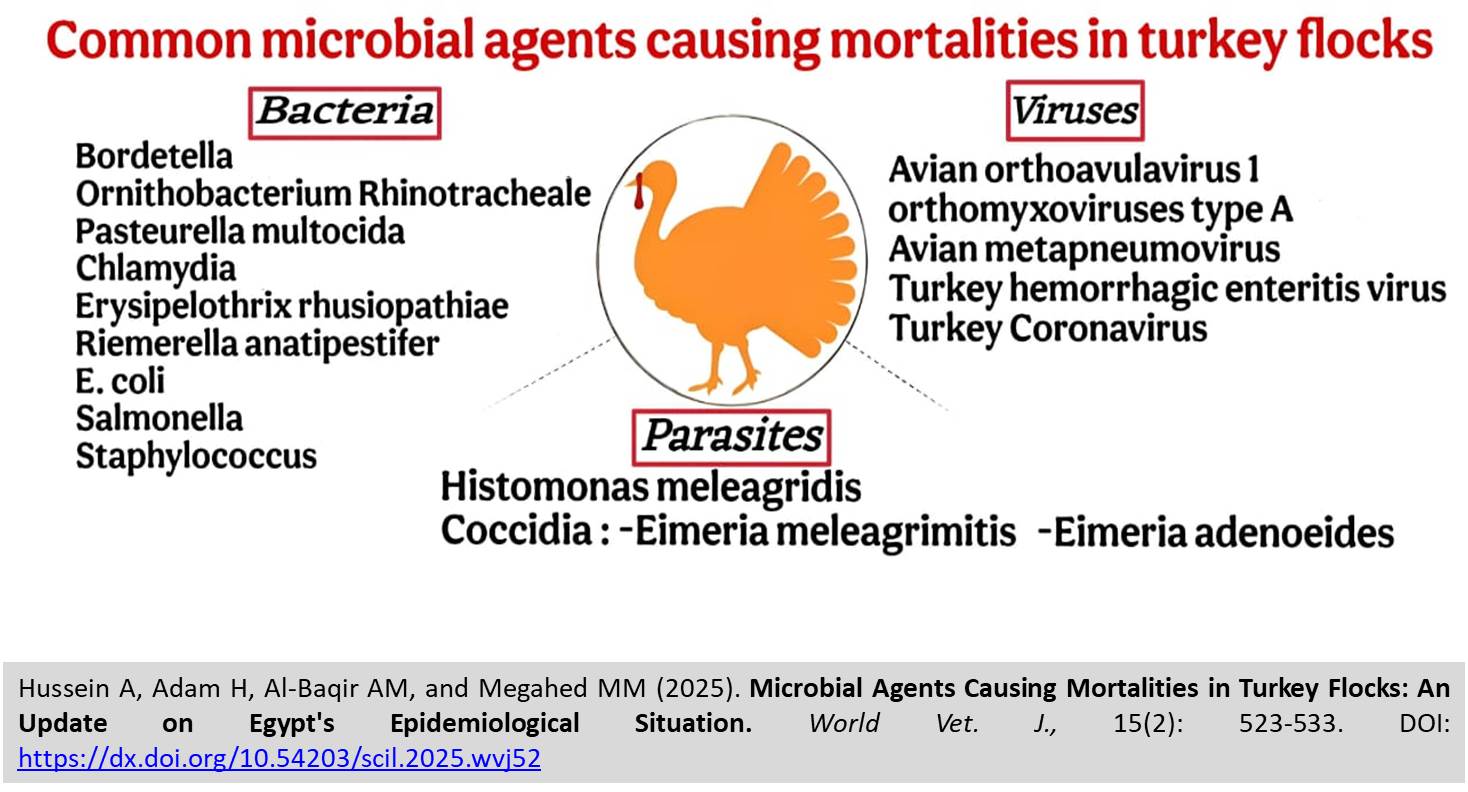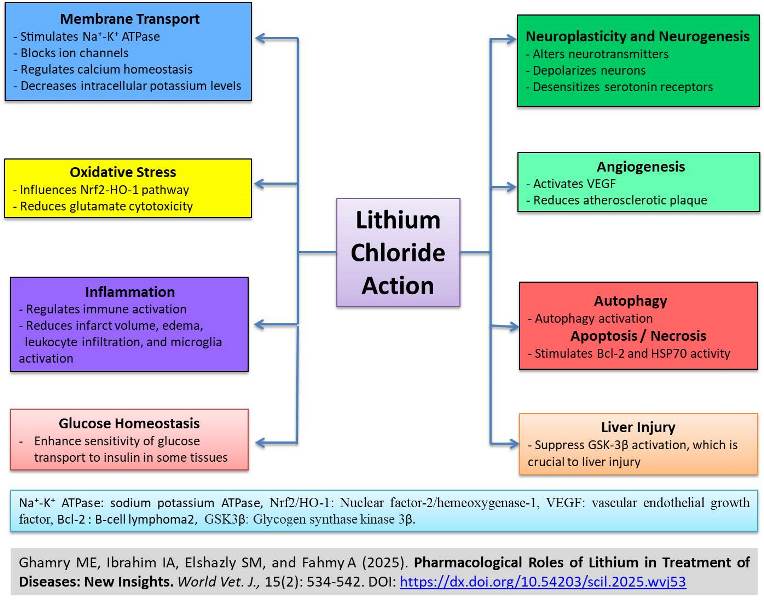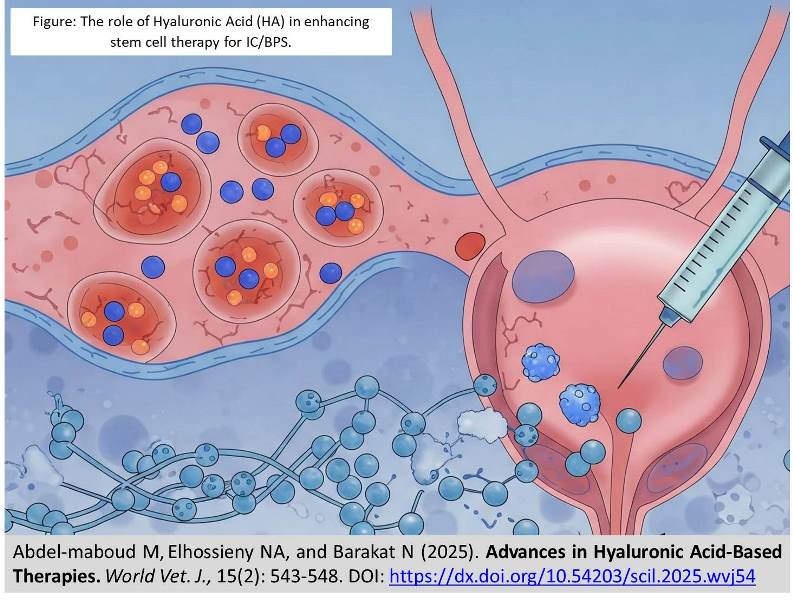Previous issue | Next issue | Archive
![]() Volume 15 (2); June, 2025 [Booklet] [EndNote XML for Agris]
Volume 15 (2); June, 2025 [Booklet] [EndNote XML for Agris]
Soft Tissue Sarcomas in Cats: A Comparative Review on Injection-Site and Non-Injection-Site Sarcomas
Wright C, Barbeito CG, Zanuzzi CN, Duchene AG, Acuña F, and Santelices Iglesias OA.
World Vet. J. 15(2): 215-223, 2025; pii:S232245682500023-15
DOI: https://dx.doi.org/10.54203/scil.2025.wvj23
ABSTRACT: Malignant tumors originating in connective tissue cells of mesenchymal origin are considered soft tissue sarcomas. Soft tissue sarcomas represent between 7%-9% of malignant tumors of the skin and subcutaneous tissue in cats. Among the sarcomas affecting cats, there is a specific group known as inoculation site-associated sarcomas. Sarcomas that do not occur at sites typically used for the injection of substances will be classified in this review as non-inoculation site-associated sarcomas. Fibrosarcoma is the most common histological type and accounts for 80–92% of soft tissue sarcomas in cats. The prevalence of non-inoculation site sarcomas in cats is 17 in 100,000, while the prevalence of inoculation site sarcomas is estimated to be between 1 in 1,000 and 1 in 10,000 vaccinated cats. The present study aimed to compare the information present in the available literature in relation to the morphological characteristics, biological behavior, pathogenesis, diagnosis, and treatment of both inoculation site-associated and non-associated sarcomas in cats. A more complete understanding of these neoplasms and their differences is essential to deepen the understanding of their genesis and progression. A better understanding could lead to the development of more effective intervention strategies that improve the quality of life and survival of cats affected by these sarcomas.
Keywords: Feline sarcoma, Inoculation site, Oncology, Soft tissue sarcoma, Vaccination
[Full text-PDF] [Crossref Metadata] [Scopus] [Export from ePrint]
Detection of Luteinizing Hormone Receptor in Holstein Friesian Dairy Cows Undergoing Repeat Breeding
Madyawati SP, Prastiya RA, Srianto P, Pradana M, Yansri AA, and Kholik K.
World Vet. J. 15(2): 224-228, 2025; pii:S232245682500024-15
DOI: https://dx.doi.org/10.54203/scil.2025.wvj24
ABSTRACT: The tropical climate in Indonesia will cause heat stress in imported cattle, such as Holstein Friesian dairy cows, which farmers in East Java Province widely keep. Heat stress can cause repeat breeding cases caused by failure in ovulation, which is greatly influenced by luteinizing hormones, whose receptors are found in the blood. This study aimed to detect luteinizing hormone (LH) gene receptors in the blood of dairy cows undergoing repeat breeding. This research was conducted from April to August 2023 using 4 randomly drawn 30 Holstein Friesian dairy cows with repeat breeder cases at the Wilis Farmer Village Unit cooperative. East Java. A ten-milliliter blood sample was taken from the jugular vein of each Holstein Friesian Dairy Cow and placed into a sterile tube. Deoxyribonucleic acid (DNA) extraction of luteinizing hormone gene receptors from the blood of Holstein Frisian dairy cows was done using a DNA extraction kit. DNA amplification of the receptor gene of the luteinizing hormone of Holstein Frisian dairy cows' blood was done using the PCR method, and DNA amplification was checked by 1% agarose electrophoresis. The results of the luteinizing hormone gene receptor from the blood of four Holstein Frisian dairy cows undergoing repeat breeding at the Tani Wilis Village Unit cooperative, East Java, were at 600 bp on gel electrophoresis. The LHR gene profile is potentially used as a marker to detect dairy cows with repeat breeding under heat stress.
Keywords: Blood, Cow, Luteinizing hormone, Receptor gene, Repeat breeding
[Full text-PDF] [Crossref Metadata] [Scopus] [Export from ePrint]
GATA4 Gene Expression Pattern and Stomach Histogenesis in White New Zealand Rabbit Fetus (Oryctolagus cuniculus)
Nouh DS, Kilany MS, Ibrahim N, Elsheikh EH, and Elsheikh E.
World Vet. J. 15(2): 229-237, 2025; pii:S232245682500025-15
DOI: https://dx.doi.org/10.54203/scil.2025.wvj25
ABSTRACT: There is a scarcity of published data regarding embryonic development in rabbits. The current study was conducted to evaluate the development of the stomach in rabbit fetuses and the expression of the transcription factor GATA4 during different stages of development. This study was conducted on 40 rabbit fetuses for morphology, histology, and GATA4 expression. The rabbits used were seemingly healthy white New Zealand pregnant females (aged 1.5- 3 years and weighing 2- 4.5 kg). The morphology and histology of rabbit fetuses' stomachs (22 fetuses) were examined using a light microscope on days 10, 12, 13, 14, 16, 18, 20, 22, and 26 of the rabbit's gestation period. The expression of GATA4 in rabbit fetuses (18 fetuses) on developmental days (20, 22, and 26) was investigated using quantitative real-time PCR (qRT-PCR). The results indicated that the initial stomach appeared as a fusiform widening in the posterior part of the foregut on day 10. The mucous membrane was significantly thickened, and the formation of the gastric gland commenced on day 18. On day 22, the lining epithelium transformed into the pseudostratified epithelium, and the mucosal folds exhibited more clarity. On day 26, the lining epithelium of the stomach had changed into a simple columnar epithelium. Additionally, the mucosal folds and gastric pits were fully developed in all stomach areas. The stomach glands displayed exceptional transparency and were fully developed. Analysis of qRT-PCR data showed a significant increase in GATA4 mRNA expression in the embryonic stomach on gestational days 20, 22, and 26 as the pregnancy progressed. In conclusion, this study comprehensively described the morphological and histological development of the rabbit stomach. It demonstrated a substantial upregulation of GATA4 mRNA expression as gestation advanced, indicating its crucial role in stomach development.
Keywords: Development, Fetus, GATA4, Primitive stomach, Rabbit
[Full text-PDF] [Crossref Metadata] [Scopus] [Export from ePrint]
Evaluation of Crescentia cujete L. Extract as a Promoter of Skin Wound Healing in Sprague-Dawley Rats
Pangaribuan MJA, Sutrisno B, Widyarini S, Prakoso YA, and Utami R.
World Vet. J. 15(2): 238-247, 2025; pii:S232245682500026-15
DOI: https://dx.doi.org/10.54203/scil.2025.wvj26
ABSTRACT: Wound is a tissue that easily disintegrates and requires proper management to promote its healing. One of the wound management techniques for effective healing is the use of herbal remedies such as Crescentia cujete (L.). The current study aimed to analyze the potential of Crescentia cujete (Buah berenuk extract, or BBE) in a cream-based formulation as a healing promoter in excision wounds in rat models. The present study involved 32 male Sprague Dawley rats, 3-month-old and weighing 251.81 ± 7.07 g. Two full-thickness circular wounds (6 mm diameter) were created on the shaved dorsal skin of each rat. The rats were divided into four groups, including untreated (K1), treated with 1% ascorbic acid cream (K2), 1% BBE cream (K3), and 2% BBE cream (K4). The biochemical compounds of BBE were tested using high-performance liquid chromatography (HPLC) for the level of ascorbic acid and conventional quantitative methods for other biochemical compounds, including flavonoids, alkaloids, tannins, saponins, and triterpenoids. Treatments were applied once daily for seven days. On days three and seven, four rats from each group were euthanized using cervical dislocation, and their skin samples were collected. The skin was tested using macroscopy, histopathology, collagen density analysis, and immunohistochemistry (IHC) against interleukin-6 (IL-6) and fibroblast growth factor (FGF). Statistical analysis was performed on the obtained data. The results demonstrated that BBE contained alkaloid, flavonoid, phenolic, saponin, tannin, and ascorbic acid. The current findings revealed that the use of 2% BBE cream had significant impacts on wound area in rat models, affecting histopathology, skin collagenization, and the immunoreactivity of IL-6 and FGF when compared to the other treatment groups.
Keywords: Collagen, Crescentia cujete L., Excision wound, Fibroblast growth factor, Interleukin-6
[Full text-PDF] [Crossref Metadata] [Scopus] [Export from ePrint]
Identification and Characterization of Lactic Acid Bacteria Isolated from Fermented Camel Milk in Kenya
Gulled MA, Kariuki DW, and Omolo KM.
World Vet. J. 15(2): 248-255, 2025; pii:S232245682500027-15
DOI: https://dx.doi.org/10.54203/scil.2025.wvj27
ABSTRACT: Somali camel milk is a vital dietary component for pastoral communities in Kenya's arid and semi-arid lands (ASAL) such as Baringo, Marsabit, Isiolo, Madera, Wajir, and Garissa, due to its high nutritional value. Camel milk provides approximately 50 kcal per 100 mL and contains nearly 2-3% protein, 3-4% fat, and 4-5% carbohydrates. It is also a source of essential minerals (calcium, magnesium, potassium, and iron) and vitamins (C, B, and A). Traditional fermenting of camel milk is practiced by pastoral communities to enhance its nutritional content, digestibility, and shelf life. The purpose of this study was to isolate and identify the antimicrobial potential of lactic acid bacteria (LAB) from the Somali breed of camel milk sourced from Mombasa, Isiolo, and Kajiado counties in Kenya. LAB from the milk samples was cultured on de Man, Rogosa, and Sharpe (MRS) agar. Based on morphological and biochemical characteristics, twenty-three cocci-shaped LAB isolates were selected for further analysis. All of the LAB isolates were positive for Gram staining and Triple Sugar Iron tests but negative for the catalase test. The LAB isolates showed no hemolytic activity and inhibited the growth of Staphylococcus aureus and Escherichia coli. One isolate also inhibited the growth of Candida albicans. Molecular analysis targeting 16S rRNA identified Enterococcus faecium, Enterococcus durans, Leuconostoc mesenteroides and leuconostoc pseudomesentroides among the isolates. The findings revealed fermenting and antimicrobial properties of LAB isolated from fermented milk derived from the Somali breed of camel. These LAB isolates were found to be potentially useful for the development of starter cultures in the production of probiotics.
Keywords: Antimicrobial activity, Camel milk, Enterococcus fermentation, Lactic acid bacteria, Leuconostoc
[Full text-PDF] [Crossref Metadata] [Scopus] [Export from ePrint]
Physicochemical Properties of Cottage Cheese Produced Using Bromelain Enzyme Powder Derived from Ananas comosus
Wanniatie V, Salsabila N, Suryani NA, Qisthon A, Septinova D, and Zelfina E.
World Vet. J. 15(2): 256-263, 2025; pii:S232245682500028-15
DOI: https://dx.doi.org/10.54203/scil.2025.wvj28
ABSTRACT: Lampung Province is a producer of canned pineapple in Indonesia. Waste from the pineapple canning process, in the form of cobs and skins, is used as a powdered bromelain enzyme. Bromelain enzyme is thought to have the same function as rennet in the cheese-making process. This study aimed to determine the effect of using bromelain enzyme from Ananas comosus on the physical quality (curd yield, hardness, and adhesiveness) and chemical quality (protein, fat, and moisture content) of cottage cheese. The study was conducted using a Completely Randomized Design (CRD) with four treatment groups (0.5%, 0.6%, 0.7%, and 0.8% bromelain enzyme concentrations), each replicated five times. Results indicated that a bromelain concentration of 0.6% yielded the highest curd and cheese hardness, while a concentration of 0.7% produced the highest fat content and strongest adhesiveness. Additionally, a concentration of 0.8% resulted in the highest protein content, reducing the water content in the cheese. These findings suggest that bromelain enzyme concentrations between 0.6% and 0.8% are suitable for cheese production.
Keywords: Bromelain enzyme, Cottage cheese, Fresh cheese, Physicochemical properties, Ananas comosus
[Full text-PDF] [Crossref Metadata] [Scopus] [Export from ePrint]
Molecular Prevalence and 16s rRNA Gene Analysis of Ehrlichia canis in Dogs in Ho Chi Minh City, Vietnam
Nguyen LVTH, Nguyen DV, and Du VT.
World Vet. J. 15(2): 264-273, 2025; pii:S232245682500029-15
DOI: https://dx.doi.org/10.54203/scil.2025.wvj29
ABSTRACT: Ehrlichiosis has been recognized as one of the leading tickborne vector diseases affecting the canine population. The present study aimed to determine the infection rate of Ehrlichia canis (E. canis) in dogs in Ho Chi Minh City, Vietnam. From June 2024 to December 2024, a total of 3,752 dogs were brought for initial veterinary examination due to various health concerns at the K9 Veterinary Clinic System, which operates in Districts 1, 4, 5, 7, and 8 of Ho Chi Minh City, Vietnam. These dogs represented a wide range of breeds, including indigenous dogs, Poodles, Corgis, Chihuahuas, and French Bulldogs, among others. The age of dogs ranged from 3 months to 12 years, with a mean age of approximately 4 years. Body weights varied depending on breed and age. Dogs exhibiting clinical signs suggestive of E. canis infection were further evaluated using a combination of diagnostic methods, including a rapid antibody test, blood smear staining for morulae detection, and polymerase chain reaction (PCR). The results showed that 87 out of 3,752 dogs (2.32%) were infected with E. canis based on PCR. The most common clinical signs observed in E. canis infected dogs included lethargy and anorexia (49.42%), pale mucous membranes (28.73%), fever (24.14%), epistaxis (16.09%), icterus (14.94%), petechiae (13.79%), and hindlimb weakness (5.75%). Hematological analysis revealed that thrombocytopenia (90.80%) and anemia (54.02%) were the most common hematological abnormalities. The 16S rRNA gene sequences from 15 E. canis isolates in this study exhibited a very high degree of similarity. Phylogenetic analysis showed considerable genetic diversity among these isolates. These findings provide valuable insights into the clinical, hematological, and molecular characteristics of E. canis infection in dogs in Vietnam and underscore the importance of molecular surveillance for improved diagnosis and disease management.
Keywords: Dog, Ehrlichia canis, Hemorrhage, Polymerase chain reaction, Phylogenetic analysis
[Full text-PDF] [Crossref Metadata] [Scopus] [Export from ePrint]
Effect of Crescentia cujete (L.) Fruit Extract as a Thread-Coating Material for Suture Implant in Rat Skin
Utami R, Widyarini S, Sutrisno B, Prakoso YA, and Pangaribuan MJA.
World Vet. J. 15(2): 274-282, 2025; pii:S232245682500030-15
DOI: https://dx.doi.org/10.54203/scil.2025.wvj30
ABSTRACT: Thread coatings on suture implants are designed to enhance biocompatibility and biodegradability, supporting wound healing by reducing inflammation and accelerating collagen density. Ascorbic acid, an antioxidant found in specific coatings, can help to increase collagen density. One specific antioxidant is derived from the calabash fruit (Crescentia cujete-Linnaeus). Using a rat model, this study evaluated the effectiveness of calabash fruit extract (CFE) as a suture material for skin implants. The experiment was conducted with 16 female rats, each 12 months old and weighing 300 grams. The rats were randomly divided into four groups, including P1 (control), P2 (cannula), P3 (implanted with polydioxanone), and P4 (implanted with polydioxanone coated with 100% calabash fruit extract). The sutures were implanted on both the left and right sides of the rats' back skin. Skin samples were collected on days 3 and 7 and analyzed for histopathology, collagenization, and the immunoreactivity of interleukin-6 and fibroblast growth factor. Group P4 showed better histopathological score, collagenization, and the percentage of IL-6's immunoreactivity and FGF than the other groups. Histopathological analysis indicated reduced inflammation, smaller intradermal wound diameters, and increased fibroblasts and collagen density in P4 compared to P3 (the group with PDO without CFE coating). Additionally, P4 displayed better IL-6 and FGF immunoreactivity than the other groups. This study demonstrated that CFE can enhance skin quality following suture implantation. The significant benefits of CFE on skin histopathology, collagenization, IL-6, and FGF immunoreactivity offer promise for its potential applications in wound healing.
Keywords: Calabash fruit extract, Fibroblast growth factor, Histopathology, Interleukin-6, Suture implant
[Full text-PDF] [Crossref Metadata] [Scopus] [Export from ePrint]
Detection of Ancylostoma ceylanicum and Toxascaris leonina in Bengal Tigers (Panthera tigris) and Asian Black Bears (Ursus thibetanus) Captured at Hanoi Wildlife Rescue Center, Vietnam
Nguyen THY, Nguyen DM, and Trinh TTH.
World Vet. J. 15(2): 283-291, 2025; pii:S232245682500031-15
DOI: https://dx.doi.org/10.54203/scil.2025.wvj31
ABSTRACT: The Hanoi Wildlife Rescue Center (WRC) plays a crucial role in the rescue, care, and release of wild animals. The health of these animals was meticulously evaluated during their care and before their reintroduction into their natural habitat. An annual surveillance study of parasitic infections in wildlife at the Hanoi WRC was conducted to establish a scientific basis for developing preventive measures to manage the health of these animals. A total of 46 fresh fecal samples were opportunistically collected immediately following defecation using a shovel. These samples were obtained from 25 tigers (age: 10.8±3.6 years) and 21 bears (age: 11.2±4.6 years) captured at the Hanoi WRC in November 2024. Fecal samples were examined using sedimentation and centrifugal flotation methods to identify the presence of parasites. Subsequently, parasite eggs were collected using a micropipette for DNA extraction. Polymerase chain reaction and sequencing techniques were used to determine the parasite species. It was found that 20.0% of tigers (5 out of 25) and 23.8% of bears (5 out of 21) were infected with parasitic worms. The identification of these infections was achieved through the examination of the morphological characteristics of the eggs. This analysis identified the presence of trematode eggs, nematode eggs, including Strongyle type, and Toxascaris leonina. Molecular analysis further identified Strongyle eggs as belonging to Ancylostoma ceylanicum, which accounted for 12.0% of infections in tigers and 23.8% in bears. Additionally, Toxascaris leonina was detected exclusively in tigers, representing 12.0% of infections. Trematode eggs were found solely in tiger feces; however, molecular amplification was unsuccessful due to the insufficient number of eggs detected. The discovery of two zoonotic nematodes, A. ceylanicum and To. leonina in tigers and bears at the Hanoi (WRC) underscores the potential risk of nematode transmission from wildlife to humans and domestic animals in this area and its surrounding areas. The findings of this study will aid in the development of a prevention program aimed at controling gastrointestinal helminths in wild animals within the study region.
Keywords: Ancylostoma ceylanicum, Asian black bear, Bengal tiger, Toxascaris leonina, Wildlife Rescue Center
[Full text-PDF] [Crossref Metadata] [Scopus] [Export from ePrint]
Antimicrobial Efficacy and Chemical Composition of Essential Oils from Moroccan Medicinal Plants against Multidrug-Resistant Salmonella Strains
Sabri C, Kadiri FZ, Sabri S, Razzak S, Salam MR, and Taboz Y.
World Vet. J. 15(2): 292-304, 2025; pii:S232245682500032-15
DOI: https://dx.doi.org/10.54203/scil.2025.wvj32
ABSTRACT: The rising occurrence of multidrug-resistant bacteria underscores the critical need for alternative therapeutic approaches. This study aimed to investigate the yield, chemical composition, and antimicrobial properties of essential oils extracted from Thymus satureioides, Origanum majorana, and Rosmarinus officinalis, sourced from the Benslimane region in Morocco. Essential oils were extracted using hydrodistillation, their chemical composition was analyzed via gas chromatography-mass spectrometry (GC-MS), and their antimicrobial potential was assessed against 27 multidrug-resistant Salmonella strains. The essential oil of Thymus satureioides was primarily composed of thymol (28.7%) and borneol (21.2%). Origanum majorana contained high levels of terpinen-4-ol (34.2%), while Rosmarinus officinalis essential oil was rich in 1,8-cineole (50.3%). Thymus satureioides demonstrated the highest efficacy, with the lowest minimum inhibitory concentration (MIC: 0.15 mg/mL) and the most pronounced inhibition zones (30.3 ± 0.02 mm). Origanum majorana indicated moderate antibacterial activity. Rosmarinus officinalis, on the other hand, showed variable but generally lower efficacy, with inhibition zones reaching up to 16.6 ± 0.1 mm and MIC values ranging from 2.35 to 9.4 mg/mL. These results highlighted the promising potential of Moroccan essential oils, particularly Thymus satureioides, as natural antimicrobials to combat multidrug-resistant pathogens in food safety and clinical applications.
Keywords: Essential oil, Food, Multidrug-resistant, Origanum majorana, Rosmarinus officinalis, Salmonella, Thymus satureioides
[Full text-PDF] [Crossref Metadata] [Scopus] [Export from ePrint]
Effects of the Combination Bacillus licheniformis and Saccharomyces cerevisiae on Blood Profile, Immune Organs, Carcass Characteristics, and Intestinal Health of Broiler Chickens Challenged with Escherichia coli
Tugiyanti E, Rosidi, and Abdulai M.
World Vet. J. 15(2): 305-314, 2025; pii:S232245682500033-15
DOI: https://dx.doi.org/10.54203/scil.2025.wvj33
ABSTRACT: The poultry industry faces ongoing challenges from bacterial infections. Probiotics have emerged as a promising strategy to improve the performance and health of animals. The current research aimed to evaluate the effectiveness of the combination of Bacillus licheniformis and Saccharomyces cerevisiae on blood profile, immune organs, carcass characteristics, and intestinal health in broiler chickens exposed to Escherichia coli (E. coli). This study involved the random assignment of 100 male Cobb 500 broiler chicks aged one day, raised for 35 days, each with an average weight of 44.26 ± 1.89g, to four oral treatments. There were four groups, each group consisting of five replications, and each replication consisting of five chickens. T1, the control group, received a basal diet. T2 received B. licheniformis (5×109 CFU per 2g), administered at a level of 2g per 1000g of basal diet. T3 received S. cerevisiae (1.0 ×10 10 CFU per 2g), administered at a level of 2g per 1000g of basal diet. T4 received a combination of B. licheniformis (5×10 9 CFU/g) and S. cerevisiae )1.0 × 1010 CFU/g), with each probiotic administered at a level of 1g per 1000g of basal diet. The data of blood profile parameters, including electrolytes, leukocytes, total protein of plasma (TPP), fibrinogen, hemoglobin, LDL, HDL, triglycerides, and cholesterol, indicated a notable disparity between the control group and the group receiving the combination of Bacillus licheniformis and Saccharomyces cerevisiae, with the control group exhibiting lower values for these parameters compared to the combination group. Total bacteria counts before and after the challenge showed fewer colonies of E. coli in the group that received the combination of Bacillus licheniformis and Saccharomyces cerevisiae. The weights of carcass parts (breast, wing, and thigh) and immune organs (spleen, Bursa Fabricius, and intestine) were all significantly lower in the control group compared to the group administered a combination of Bacillus licheniformis and Saccharomyces cerevisiae. These results indicated that the supplementation of Bacillus licheniformis and Saccharomyces cerevisiae to broiler chickens exposed to E. coli increased their parameters of blood profile, immune system, carcass features, and intestinal health.
Keywords: Bacillus licheniformis, Broiler chickens, Immune function, Probiotics, Saccharomyces cerevisiae
[Full text-PDF] [Crossref Metadata] [Scopus] [Export from ePrint]
Molecular Identification of Eimeria Species in Desi Chickens Using ITS-1 rDNA PCR Analysis
Bawer MD, Danish F, Ahmadi M, Azizi MN, Mamatha GS, PuttalaKshmamma GC, and Kumar GSN.
World Vet. J. 15(2): 315-326, 2025; pii:S232245682500034-15
DOI: https://dx.doi.org/10.54203/scil.2025.wvj34
ABSTRACT: Eimeria (E.) species are protozoan parasites responsible for coccidiosis, a widespread and economically significant disease affecting all chicken breeds. Coccidiosis negatively impacts poultry health and performance, leading to substantial economic losses in the global poultry sector. The present study aimed to assess the current status of coccidiosis in desi chickens reared on farms and processed at retail poultry dressing centers in Bengaluru, Karnataka, India. A polymerase chain reaction (PCR) assay targeting the internal transcribed spacer one (ITS-1) region of ribosomal DNA (rDNA) was performed to identify Eimeria species in desi chickens (dual purpose of broilers and layers) aged one to eight weeks. Among different DNA extraction methods tested for Eimeria oocysts in desi chickens, including liquid nitrogen, hypochlorite, direct, sonication, and glass bead techniques, the glass bead method proved to be the most efficient for oocyst disruption and genomic DNA extraction. Two species, E. tenella and E. acervulina, were successfully identified based on distinct bands of 278 base pairs (bp) and 145 bp, respectively, observed on a 2% agarose gel. The minimum number of oocysts required for DNA extraction was 32 oocysts (0.10 ng) for E. tenella and 127 oocysts (0.41 ng) for E. acervulina. Amplicon sizes of 278 bp for E. tenella and 145 bp for E. acervulina were consistently obtained. Among the identified species in the present study, E. tenella was the most predominant cause of coccidiosis in desi chickens.
Keywords: Characterization, Coccidiosis, Desi chicken, Eimeria, Identification, Internal transcribed spacer one, PCR, Ribosomal DNA
[Full text-PDF] [Crossref Metadata] [Scopus] [Export from ePrint]
Contributing Factors and Management of Pyometra in Dogs of Algeria
Imane H, Baghdad K, and Mabrouk SK.
World Vet. J. 15(2): 327-334, 2025; pii:S232245682500035-15
DOI: https://dx.doi.org/10.54203/scil.2025.wvj35
ABSTRACT: Pyometra is one of the most frequent and complex reproductive pathologies in older intact bitches over eight years of age, characterized by the accumulation of purulent material within the uterus. The present study aimed to analyze the influence of predisposing factors, including age, breed, parity, and estrous cycle, on the development of pyometra and evaluate diagnostic and therapeutic approaches. Seventeen cases were recorded at the Institute of Veterinary Sciences, University of Tiaret, Algeria, from September 2021 to September 2023. Among these cases, 47.05% (n = 8) involved bitches aged from two to four years, representing the most affected age group. German Shepherds accounted for 23.52% (n = 4) of cases, followed by Rottweilers and Pitbulls with 17.64% (n = 3) each. Nulliparous bitches represented 70.59% (n = 12) of the affected dogs, indicating a higher susceptibility compared to multiparous bitches. In 35.29% (n = 6) of cases, pyometra developed approximately eight weeks after the end of the previous estrous cycle. Ultrasonography proved to be a reliable and efficient tool for diagnosing both open- and closed-cervix pyometra in bitches. Ciprofloxacin and amoxicillin with clavulanic acid were effective medicines in selected cases, while ovariohysterectomy remained the definitive therapeutic approach. Overall, the study demonstrated that young, nulliparous bitches were more susceptible to pyometra, and that both medical and surgical treatments were effective, with no recurrence observed during follow-up.
Keywords: Bitch, Nulliparous, Ovariohysterectomy, Pyometra, Ultrasound
[Full text-PDF] [Crossref Metadata] [Scopus] [Export from ePrint]
Effects of Egg Storage Duration on Hatching Traits of Commercial Layers and Crossbreds of Indonesian Local Chickens
Andri F, Nuraini TM, Maslihan MA, Marwi F, Nurwahyuni E, Yulianti DL, and Prayogi HS.
World Vet. J. 15(2): 335-340, 2025; pii:S232245682500036-15
DOI: https://dx.doi.org/10.54203/scil.2025.wvj36
ABSTRACT: Egg storage duration is highly critical to hatching performance and chick development. The objective of the present study was to assess the impact of different egg storage durations on the hatching traits of crossbred chickens. In total, 128 hatching eggs were used in this experiment. The eggs were randomly distributed into four treatments and four replications, with each replication consisting of eight eggs. The treatments were based on the storage duration of the hatching eggs, including one day (T1), four days (T2), seven days (T3), and ten days (T4). Hatching performance was evaluated by fertility, the hatchability of fertile eggs, the hatchability of set eggs, and embryonic mortality. Day-old chickens were evaluated by chicken length, chicken weight, hatch yield, pasgar score, and saleable chickens. The present study's findings indicated that egg storage duration up to ten days did not significantly influence the hatchability of fertile eggs or embryonic mortality. However, egg storage duration significantly affected the fertility and hatchability of set eggs. Eggs stored for four and seven days tended to have improved fertility and hatchability. Additionally, hatching eggs stored for ten days had the lowest fertility and hatchability of set eggs. Body weight, body length, hatch yield, and pasgar score of chickens were not significantly different among all treatments. No significant differences among T1, T2, and T3 were observed in saleable chickens. However, T4 had significantly fewer saleable chickens compared to T1, T2, and T3. It can be concluded that the hatching eggs of crossbred chickens can be safely stored for up to seven days without adverse effects on hatching traits. Extended storage beyond this period, specifically up to 10 days, could worsen key hatching performance traits of crossbred chickens.
Keywords: Crossbred chicken, Hatchability, Pasgar score, Saleable chick, Storage duration
[Full text-PDF] [Crossref Metadata] [Scopus] [Export from ePrint]
Immunoinformatics Approach to Develop a Novel Chimeric L1/L2 Messenger RNA-based Vaccine Targeting a Broad Spectrum of Human Papillomavirus Species
Sylvere N, Kimotho J, and Ngugi CW.
World Vet. J. 15(2): 341-374, 2025; pii:S232245682500037-15
DOI: https://dx.doi.org/10.54203/scil.2025.wvj37
ABSTRACT: Papillomaviruses can infect animals and humans, causing benign lesions and cancer. Chimeric vaccines may address the limited coverage of current papillomavirus vaccines by providing cross-type immunity. The present study focused on the in silico design of a chimeric mRNA vaccine targeting a wide range of human papillomaviruses (HPV). The study incorporated 25 amino acid sequences derived from L1 and L2 capsid proteins of 14 high-risk and 11 low-risk HPV strains. These sequences underwent multiple sequence alignment, and the resulting sequences were used to develop consensus sequences. Computational approaches were then applied to predict and identify immunodominant T-cell and B-cell epitopes. The mRNA vaccine structure was designed by merging codon-optimized multi-epitope chimeric peptides with regulatory components that enhance both transcription and translation efficiency. The present study identified 19 T and 6 B cell epitopes, which were evaluated as non-toxic, non-allergenic, highly antigenic, and fully or partially conserved. The final multi-epitope peptide vaccine had a molecular weight of 60,161.29 kDa, a theoretical isoelectric point (pI) of 9.44, a solubility index of 0.451, and an antigenicity score of 0.9178. The mRNA vaccine exhibited a stable mRNA structure with a minimum free energy of -731.10 kcal/mol and an estimated molecular weight of 644.98 kDa. The proposed vaccine demonstrated no cross-affinity with the human genome and attained a worldwide population coverage rate of 86.24%. The vaccine formed a stable docking complex and exhibited strong interactions with major histocompatibility class I and class II molecules, as well as Toll-like receptor 4 (TLR4), Toll-like receptor 9 (TLR9), and the B-cell receptor. Binding affinities were assessed based on free energy (ΔG) values of -34.01 kcal/mol and -20.77 kcal/mol for major histocompatibility complex (MHC) class I and II, respectively, -1377.5 kcal/mol for TLR4, -24.19 kcal/mol for TLR9, and -34.41 kcal/mol for the B-cell receptor. This vaccine triggered both antibody and cell-mediated immune responses and increasing levels of IFN-γ and the interleukins IL-2, IL-10, and IL-12. This vaccine is considered preventive against multiple HPV infections. Nonetheless, in vitro and in vivo investigations are necessary to validate the safety and efficacy of this vaccine.
Keywords: Chimeric mRNA, Immune simulation, Molecular docking, Molecular dynamics simulation, Multi-epitope peptides, Papillomavirus
[Full text-PDF] [Crossref Metadata] [Scopus] [Export from ePrint]
A Nationwide Survey on the Administration of Antibiotics in Companion Animals by Veterinary Practitioners in Nigeria
Olasoju MI, OlagunjuPS, Alamu AO, Adesokan HK, Olasoju TI, Adebayo OO, Jimoh A, Adeleye AI, and Adebowale OO.
World Vet. J. 15(2): 375-388, 2025; pii:S232245682500038-15
DOI: https://dx.doi.org/10.54203/scil.2025.wvj38
ABSTRACT: Antimicrobial use (AMU) in companion animals in Nigeria is underreported, raising public health concerns due to antimicrobial resistance (AMR). The present study aimed to establish baseline data on antimicrobial stewardship (AMS) among veterinarians treating small animals and, with a focus on prescription patterns and adherence to the World Health Organization (WHO) guidelines on the Highest Priority Critically Important Antimicrobials (HP-CIAS). A nationwide web-based cross-sectional survey was conducted between August and November 2022, utilizing an online self-administered questionnaire among 96 companion animal veterinarians (CAVs) in Nigeria. Data collected included veterinarians' demographics, diseases treated, prescribed antimicrobial agents, utilization of laboratory diagnostic tests, and veterinarians' knowledge of AMS and MAR. The survey was conducted using KoBo Toolbox (Cambridge, MA, USA), and the variables were analyzed with Epi Info version 7.1.3.10. Among the 96 respondents, 62.5% were male. The most frequently reported conditions were infectious and parasitic diseases (80.6%), followed by abscesses, injuries, and bite wounds (68.8%), and digestive system diseases (65.6%). The most commonly prescribed first-line antibiotics were oxytetracycline (81.4%) and metronidazole (56.9%), while ciprofloxacin (39.8%) and gentamicin (33.7%) were often prescribed as second-line antibiotics for companion animals. Approximately 38.3% of respondents reported 100% efficacy of the first antibiotic prescribed, while 90.3% were aware of laboratory test results before using antimicrobial agents. The data collected provides essential baseline insights into AMU patterns among CAVs in Nigeria, which are critical for guiding AMR interventions focused on responsible antimicrobial use, including the development of AMS initiatives and educational programs for veterinary practices nationwide.
Keywords: Prescription patterns, Antimicrobial resistance, Antimicrobial stewardship, Companion animals, Veterinary practice
[Full text-PDF] [Crossref Metadata] [Scopus ID: ] [Export from ePrint]
New Bacteriophages for Treating Canine External Otitis Caused by Pseudomonas aeruginosa and Staphylococcus pseudintermedius
Horiuk Y, Tsymbalisty V, Kukhtyn M, Horiuk V, Kozhyn V, and Chuhno V.
World Vet. J. 15(2): 389-398, 2025; pii:S232245682500039-15
DOI: https://dx.doi.org/10.54203/scil.2025.wvj39
ABSTRACT: Phage therapy presents a promising approach to combating bacterial infections; however, its effectiveness is constrained by limitations such as weak lytic activity, narrow host range, and stability issues. Overcoming these challenges requires further research aimed at isolating new specific phages, developing phage cocktails, and expanding the host range to maximize the effectiveness of phage therapy. The present study aimed to isolate and characterize bacteriophages targeting Pseudomonas aeruginosa and Staphylococcus pseudintermedius, which are the key pathogens responsible for canine external otitis. The study, conducted from 2023 to 2024 in veterinary clinics, involved 496 dogs of different ages, genders, and breeds. The current result revealed that three P. aeruginosa phage strains (Pa3, Pa7, Pa15) and three S. pseudintermedius phage strains (Sp6, Sp10, Sp17) showed high specificity and lytic activity against the corresponding pathogenic microorganisms isolated from dogs with signs of external otitis. All phages formed clear plaques on nutrient media, indicating their ability to destroy bacterial cells. The lytic activity of the phages was higher for Pa7 and Pa15, which lysed up to 92.8% of P. aeruginosa strains, while the Pa3 phage was active only against 71.4% of the strains. While phages Sp6 and Sp10 demonstrated superior lytic activity against S. pseudintermedius, Sp17 indicated the highest efficacy against canine-derived S. aureus isolates. The optimal phage-to-bacteria ratio for maximum effect was 0.0001 for all the studied phages. The latent period of the phages was up to 30 minutes, and virions were released in significant amounts within an hour after infection. The results demonstrated that all the phages exhibited high stability at temperatures ranging from +4°C to +40°C and within a pH range of 5 to 10, confirming their potential for use in the treatment of external otitis dogs. The results suggested that bacteriophages Pa3, Pa7, and Pa15 for P. aeruginosa, and Sp6, Sp10, and Sp17 for S. pseudintermedius are promising candidates for use in phage therapy for bacterial infections in dogs, as they exhibit high lytic activity, stability, and specificity towards their hosts.
Keywords: Dog, Otitis, Phage specificity, Phage stability, Pseudomonas aeruginosa, Staphylococcus pseudintermedius
[Full text-PDF] [Crossref Metadata] [Scopus] [Export from ePrint]
Transient Paralysis Associated with Marek’s Disease Virus (MDV) in a Poultry Flock
Barari M, Danaeifard MR, Shirazi MHN, Dezfoulian O, Sasani F, and Razmyar J.
World Vet. J. 15(2): 399-406, 2025; pii:S232245682500040-15
DOI: https://dx.doi.org/10.54203/scil.2025.wvj40
ABSTRACT: Transient paralysis (TP) is a non-neoplastic neurological disorder in poultry caused by Marek’s Disease Virus (MDV). It is characterized by temporary ataxia and paresis, primarily due to inflammatory damage in the central nervous system (CNS) rather than neoplastic transformation. The present study reported an outbreak of MDV-induced TP in a commercial 80,000 Lohmann LSL-Lite layer flock aged 95 days in Alborz Province, Iran, where affected hens exhibited sudden-onset paralysis and ataxia, with those that survived recovering spontaneously within three to five days without intervention. Although the flock had been vaccinated against MDV at hatch, neurological signs appeared at 95 days of age. Cerebellar samples were collected from ten clinically affected hens, including five collected postmortem from deceased chickens and five from live chickens that were humanely euthanized. Real-time polymerase chain reaction (PCR) confirmed infection with MDV field strains through strong amplification of pp38-Vir (1) and pp38-Vir (3) probes. In contrast, the CVI988 vaccine strain was not detected in samples collected at 95 days post-vaccination, which raised concerns regarding the quality of the vaccine and the proper administration of vaccination protocols. Histopathological examination of cerebellar tissues from three hens revealed vasogenic edema, perivascular cuffing, vasculitis, and widespread inflammatory cell infiltration. No evidence of tumor formation, mitotic activity, or neoplastic lymphoid proliferation was observed. These findings helped to distinguish TP from classical neoplastic Marek’s Disease. The present study highlighted the need for early and accurate differentiation of TP from other neurological disorders, such as ionophore toxicity, botulism, and vitamin deficiencies, given its transient condition. The occurrence of TP in a vaccinated flock emphasizes the complexity of MDV pathogenesis, possible shortcomings in vaccine efficacy or its application practices, and the need for improved immunization strategies and biosecurity measures. Early molecular diagnostics and histopathological evaluation are essential for managing MDV-induced TP and mitigating its impact on poultry farms.
Keywords: Field strain, Histopathological examination, Marek’s disease virus, Neurological disorder, Real-time PCR, Transient paralysis
[Full text-PDF] [Crossref Metadata] [Scopus] [Export from ePrint]
Fertility Restoration in Progestogen-Treated Hungarian Wirehaired Vizslas: Effects of GnRH Agonist on Reproductive Activity
Zhelavskyi M, Kernychnyi S, Tsvilikhovskyi V, Mizyk V, Betlinska T, and Luchkа M.
World Vet. J. 15(2): 407-420, 2025; pii:S232245682500041-15
DOI: https://dx.doi.org/10.54203/scil.2025.wvj41
ABSTRACT: Deslorelin implants are increasingly utilized in veterinary reproductive management as a reversible alternative to surgical sterilization in dogs. The present study evaluated the biphasic response to deslorelin (Suprelorin®, 4.7 mg; Virbac®, France) in Hungarian Wirehaired Vizsla bitches after long-term progestogen-induced estrus suppression and assessed its efficacy for estrus induction and hormonal response sterilization. Thirty healthy bitches, aged 2-3 years and weighing from 19.8 to 23.7 kg, were enrolled in the study, which was divided into three groups, including a control group (C1) and two experimental groups (E1 and E2), each comprising 10 bitches. All of these dogs received subcutaneous deslorelin implants during anestrus. In E1, bitches previously treated with medroxyprogesterone acetate for 18 to 24 months received the implant for estrus induction, which was surgically removed on day 7. In E2, the implant was used for prolonged estrus suppression. Cytology and hormone analysis samples (progesterone, luteinizing hormone) were collected from the cephalic vein at specific time points; during anestrus (day 160), before implantation in controls, proestrus (day 3), estrus (days 1-3), the flare-up phase (72 hours post-implantation), and post-removal (day 7, group E1). Diestrus was monitored on days 7, 9, 11, 14, 15, 30, and 60 for the E2 group under suppression. Cytological assessment was performed using Diff-Quik™ staining, and hormone levels were measured via chemiluminescent immunoassay and ELISA. Ultrasonography and physical examination were used to monitor reproductive tract status. The present study confirmed a biphasic response to deslorelin, characterized by an initial flare-up phase, during which luteinizing hormone (LH) levels and estrous behavior were elevated, peaking on days 3 or 4, followed by effective suppression from day 14 through day 60. Implant removal in group E1 successfully induced fertile estrus, demonstrating Suprelorin's utility for fertility restoration in progestogen-treated bitches. In group E2, the implant provided sustained reproductive suppression for up to 12 months without adverse effects. These results highlighted the dual role of deslorelin in inducing or suppressing estrus, providing a valuable, evidence-based pharmacological option for managing canine reproduction.
Keywords: Deslorelin, Estrus induction, Hormonal sterilization, Luteinizing hormone, Progesterone, Reproductive management
[Full text-PDF] [Crossref Metadata] [Scopus] [Export from ePrint]
Prevention of Colibacillosis and Its Impact on Broiler Chickens' Heart with Javanese Cardamom and Turmeric
Hartady T, Sugandi SD, Septiyani, Hiroyuki A, and Goenawan H
World Vet. J. 15(2): 421-433, 2025; pii:S232245682500042-15
DOI: https://dx.doi.org/10.54203/scil.2025.wvj42
ABSTRACT: Colibacillosis represents a major threat to vital organs, particularly the heart, in broiler chickens. Concerns over rising antibiotic resistance have prompted interest in alternative therapies utilizing active compounds such as 1,8-cineole from Javanese cardamom essential oil (JCEO) and curcumin from turmeric ethanol extract (TEE), both known for their antibacterial and anti-inflammatory properties. This study aimed to evaluate the histopathological effects of JCEO and TEE and to determine the optimal dosage for reducing heart tissue damage caused by colibacillosis in broiler chickens. A total of 72 Cobb-strain day-old chicks (DOCs) were randomly allocated into eight groups (three chickens per group, three replications). The groups included a negative control (no E. coli infection or treatment), a positive control (E. coli infection without treatment), and six treatment groups including E. coli + JCEO (0.06 ml/kg BW) + TEE (400 mg/kg feed), E. coli + JCEO (0.1 ml/kg BW) + TEE (400 mg/kg feed), E. coli + JCEO (0.06 ml/kg BW), E. coli + JCEO (0.1 ml/kg BW), E. coli + TEE (400 mg/kg feed), and E. coli + ciprofloxacin (10 mg/kg BW). Colibacillosis was induced via intraperitoneal injection of E. coli strain O78 at four weeks of age, and herbal treatments were administered orally via drinking water from day 7 to week 5. Histopathological evaluation of heart tissues was conducted, scoring lesions as mild, moderate, or severe. The positive control group exhibited the highest total lesion score, indicating extensive heart damage, while the group treated with JCEO (0.1 ml/kg BW) + TEE (400 mg/kg feed) showed the lowest lesion score, suggesting strong protective effects. Severe lesions were notably observed in the ciprofloxacin and TEE-only groups. The combination of JCEO (0.1 ml/kg BW) + TEE (400 mg/kg feed) proved most effective in minimizing heart tissue damage, outperforming both single-agent treatments and ciprofloxacin, likely due to synergistic antibacterial and anti-inflammatory actions.
Keywords: 1,8-cineole, Antibacterial, Anti-inflammatory, Colibacillosis, Curcumin
[Full text-PDF] [Crossref Metadata] [Scopus] [Export from ePrint]
Infestation of Ixodes ricinus with Babesia spp. in Natural and Anthropogenic Habitats of Kharkiv Region and Its Relationship with the Detection of Canine Babesiosis
Sumakova N, Paliy A, Bogach M, Kiptenko A, Bohaсh O, Pavlichenko O, Roman L, and Bohach D.
World Vet. J. 15(2): 434-444, 2025; pii:S232245682500043-15
DOI: https://dx.doi.org/10.54203/scil.2025.wvj43
ABSTRACT: Among parasitic diseases in dogs, babesiosis plays a significant role as a natural-focal, tick-borne hemoparasitic disease caused by protozoa of the genus Babesia, which invade erythrocytes. The present study aimed to determine the prevalence of Ixodes ricinus ticks infected with Babesia spp. and to assess the epizootiological characteristics of canine babesiosis distribution in various districts of Kharkiv region and the city of Kharkiv during 2012–2023, taking into account seasonal dynamics, age-related susceptibility of dogs, and conditions of the urban environment. A total of 2,690 I. ricinus ticks were collected from natural habitats: 1,955 from the Kharkiv Region and 735 from the city, including 294 obtained from dogs. Tick sampling was conducted in parks and residential areas using the flagging method (2 km routes, May 10–20). Ticks were examined morphologically to determine developmental stage and species. In total, 1,486 dog blood samples were analyzed (578 from the region and 908 from the city). Babesia parasites were identified via microscopy of methanol-fixed, Giemsa-stained thin blood smears from the ear vein. Samples were positive if Babesia trophozoites or paired pyriform merozoites were observed in erythrocytes. I. ricinus ticks infected with Babesia were found in all studied areas. From 2012 to 2023, average infection rates were 27.8% for nymphs and 35.8% for imago. The infection rate among dogs following tick bites was 36.9%. In the city parks, 48.9% of ticks were infected, compared to 39.7% in residential zones. Among ticks removed from dogs, 52.4% carried Babesia, and 46.1% of bitten dogs had babesiosis. The age group most affected in the region was dogs aged 5-6 years (37.7%), followed by 2-4 years (28.8%) and 7-9 years (25.3%). In Kharkiv city, the highest incidence was also in 5-6-year-old dogs (50.7%). Puppies (6 months to 1 year) and dogs over 10 years indicated the lowest rates of incidence (below 5%). Seasonal peaks occurred in April–May (18.3-22.7%) and September (16.1%), indicating clear patterns of disease activity. Thus, babesiosis remains a relevant parasitic disease in dogs in the region, requiring continuous epizootiological monitoring and effective prevention.
Keywords: Babesiosis, Dog, Imago, Nymph, Tick
[Full text-PDF] [Crossref Metadata] [Scopus] [Export from ePrint]
Antibody Responses in Pigs Induced by Inactivated Vaccine Against Streptococcus suis Formulated with Montanide ISA 201 and Montanide Gel 01 Adjuvants
Kaler IGBUA, Sari NKWC, Suwiti NK, Mahardika IGNK, and Besung INK.
World Vet. J. 15(2): 445-451, 2025; pii:S232245682500044-15
DOI: https://dx.doi.org/10.54203/scil.2025.wvj44
ABSTRACT: Streptococcus suis (S. suis) is a zoonotic pathogen responsible for streptococcosis, causing substantial economic losses in swine production worldwide. The present study evaluated the humoral immune response in 8-week-old Landrace pigs immunized with an inactivated autogenous S. suis vaccine formulated with either Montanide™ ISA 201 VG or Gel 01 adjuvants. A completely randomized experimental design assigned 12 male, 8-week-old Landrace male pigs to three groups. The control group received Montanide™ ISA 201 VG adjuvant without antigen (P1), the second group received antigen and Montanide™ ISA 201 VG (P2), and the third group received antigen and Montanide™ Gel 01 (P3). Vaccination was performed by intramuscular injection into the neck muscle using 4 mL of vaccine suspension. Serum samples from all groups were collected weekly for nine weeks post-vaccination, and antibody titers were quantified using an indirect enzyme-linked immunosorbent assay. Clinical parameters, including body temperature, behavioral changes, and weight gain, were monitored weekly for nine weeks. Both adjuvanted vaccine groups (P2 and P3) demonstrated significantly higher antibody titers compared to the control group, with no significant difference between adjuvant types. A progressive increase in antibody levels was observed from week one to week nine in Groups 2 and 3. No vaccine-associated adverse effects were noted. The S.suis vaccine formulated with either Montanide™ ISA 201 VG or Montanide™ Gel 01 adjuvants demonstrated a proper safety profile, with no adverse effects on health or growth performance, and was effective in stimulating strong antibody responses in Landrace pigs. The average antibody titer produced by the vaccine using Montanide™ ISA 201 VG was 0.404 ± 0.201, whereas the vaccine with Montanide™ Gel 01 achieved a titer of 0.404 ± 0.199. The adjuvants elicited comparable immune responses in pigs with no statistically significant difference in antibody titers. The present findings indicated that Montanide™ ISA 201 VG and Montanide™ Gel 01 adjuvants effectively enhanced the immunogenicity of inactivated S. suis vaccines in Landrace pigs.
Keywords: Antibody response, Oil-based adjuvant, Streptococcus suis, Swine vaccine, Vaccine efficacy
[Full text-PDF] [Crossref Metadata] [Scopus] [Export from ePrint]
Morphological and Functional Characteristics of the Heart under Chronic Ischemic Injury Conditions Following the Use of Allogeneic Biomaterial in Rats
Anna L, Lyalya M, Alexey P, and Vladimir P.
World Vet. J. 15(2): 452-459, 2025; pii:S232245682500045-15
DOI: https://dx.doi.org/10.54203/scil.2025.wvj45
ABSTRACT: One of the scientific approaches to correcting fibrotic myocardium is the development of regenerative medicine methods, which involve tissue therapy. The present study aimed to identify morphological and functional changes in the fibrous myocardium of rats after cryoinjury and the use of allogeneic biomaterial. The study included 80 Wistar rats divided into two groups, the control and the experimental group. All rats underwent a thoracotomy under general anesthesia with Xylazine and Zolazepam, and a section of the left ventricle was frozen with a cooled metal stylet. In the experimental group, a repeated thoracotomy was performed 45 days after cryodestruction. An allogeneic biomaterial suspension, dispersed from an acellular extracellular matrix with a particle size of 50 to 80 μm, was then injected intracardially into the area of cryogenic myocardial necrosis at a dose of 3 mg per animal. Forty-five days after the allogenic biomaterial injection, the tolerance of rats to physical activity was assessed using the modified Porsolt test. After the tolerance test, the weight of the heart, the thickness of the left ventricular wall, the thickness of the scar, and the diameter of the damaged area were measured. Three myocardium samples were taken from each animal and processed for examination using a light microscope. Histological examination of the myocardium samples revealed an avascular scar. In the experimental group, the thickness of the muscular part was significantly higher than in the control group. Meanwhile, heart weight didn’t differ much between the control and experimental group. The exercise tolerance of rats in the experimental group was higher than that of the control group and did not differ significantly from the intact values. The presented results supported the allogeneic biomaterial's positive influence on the rats' myocardium structure that had undergone cryogenic destruction.
Keywords: Allogeneic biomaterial, Chronic ischemic injury, Cryodestruction, Heart, Myocardium
[Full text-PDF] [Crossref Metadata] [Scopus] [Export from ePrint]
The Effectiveness of Catfish Oil in Accelerating the Healing of Incised Wounds in Mice
Mustika AA, Sutardi LN, Andriyanto, Cahyono, Purohita AS, and Safitri N.
World Vet. J. 15(2): 460-465, 2025; pii:S232245682500046-15
DOI: https://dx.doi.org/10.54203/scil.2025.wvj46
ABSTRACT: The wound healing process naturally progresses through several phases, including hemostasis, inflammation, fibroplasia, and maturation. The present study aimed to evaluate the efficacy of gel and cream formulations of catfish oil in promoting wound healing in mice. The present study consisted of eight groups, each with five mice. The groups included a cream base of catfish oil (P1), a gel base of catfish oil (P2), fish gel at 1% (P3), fish gel at 2% (P4), fish cream at 1% (P5), fish cream at 2% (P6), povidone iodine (P7), and a commercial ointment (P8). The preparations were applied in an adequate amount to the injured skin surface. The mice were subjected to a 2-centimeter incision wound and treated once daily for 14 days. The parameters observed included signs of inflammation, such as redness, swelling, and discharge. Formulations containing 1% and 2% catfish oil facilitated faster wound healing compared to plain cream and gel, proving to be as effective as povidone iodine and commercial ointments. Specifically, the gel preparation containing 1% catfish oil, the cream formulation with 1% catfish oil, and the 2% catfish oil formulation yielded the most promising results in accelerating the healing time of incision wounds in mice.
Keywords: Catfish oil, Cream, Gel, Mice, Wound
[Full text-PDF] [Crossref Metadata] [Scopus] [Export from ePrint]
Novel Approaches for Controlling Enteric Bacteria in Dairy Farms
Zaki MSA, Abd-El-All AMM, Megahed A, Al-Ashery MA, and Attia ASA.
World Vet. J. 15(2): 466-476, 2025; pii:S232245682500047-15
DOI: https://dx.doi.org/10.54203/scil.2025.wvj47
ABSTRACT: Escherichia coli (E. coli), Staphylococcus aureus, and Salmonella enteritidis are virulent bacterial pathogens that cause serious infections on dairy farms. Nano-based disinfectants are a promising area for antibacterial applications, including chitosan nanoparticles (ChNPs) and silver nanoparticles (AgNPs). This study aimed to evaluate the antimicrobial activity of two commercial disinfectants, ChNPs and AgNPs, against Escherichia coli O26 (E. coli O26), Staphylococcus aureus, and Salmonella enteritidis isolated from three dairy farms in the Sharqia governorate, Egypt. After applying 5% hydrogen peroxide, 10% iodine, 5% silver-hydrogen peroxide nanoparticles (Ag-H2O2 NPs), 5% chitosan-hydrogen peroxide nanoparticles (Ch-H2O2 NPs), 10% silver iodide nanoparticles (Ag-I NPs), and 10% chitosan iodide nanoparticles (Ch-I NPs) individually and in combination, the viability of fifty-three strains—comprising 7 E. coli O26, 43 Staphylococcus aureus, and 2 Salmonella enteritidis—was tested using a quantitative suspension method in the presence or absence of organic matter at varying contact times. The tested strains of E. coli O26, Staphylococcus aureus, and Salmonella enteritidis predominated in the samples at 17.07%, 39.45%, and 50%, respectively. Additionally, the in vitro experiments revealed that the most effective (100%) and fastest (less than a minute) bactericidal effect was achieved by the combination of H2O2-Iodine, loaded AgNPs, ChNPs, and their complexes. The results indicated that bactericidal efficacy depended on factors such as organic matter presence, contact time, and disinfectant concentration. Nano-based disinfectants combining silver, chitosan, and the H2O2-Iodine complex proved to be highly effective biocidal agents against pathogenic E. coli O26, Staphylococcus aureus, and Salmonella enteritidis. When two or more antimicrobial agents are combined, they can offer a valuable tool for controlling pathogenic bacteria.
Keywords: Chitosan, Commercial disinfectant, Dairy farm, Nano-based disinfectant, Silver nanocomposite
[Full text-PDF] [Crossref Metadata] [Scopus] [Export from ePrint]
Association of Genetic Polymorphisms in HSF1 and HSPA6 Genes with Growth and Adaptation traits in Barki Lambs
Abousoliman I, Abd El-Hamid IS, Ismail IM, and Sallam AM.
World Vet. J. 15(2): 477-486, 2025; pii:S232245682500048-15
DOI: https://dx.doi.org/10.54203/scil.2025.wvj48
ABSTRACT: Barki is a sheep breed that is well-adapted to the harsh environmental conditions in Egypt without compromising its reproduction and productivity. Further, it remarkably contributes to the livelihood of many breeders, particularly in the desert regions of Egypt. This study investigated potential polymorphisms in the HSF1 and HSPA6 genes and their impacts on growth, adaptation traits, and blood parameters in 194 Barki lambs. Growth traits included birth weight, weaning weight (WW), and weights at 6 (W6) and 9 (W9) months of age. Adaptation traits included respiration rate, heart rate, body temperature, rectal temperature, and hormonal and biochemical blood profiles. The PCR-Restricted Fragment Length Polymorphism technique was applied to detect the allelic and genotypic frequencies of HSF1 and HSPA6 genes using SmaI and Cfr42I (SacII) restriction enzymes, respectively. The HSF1 exhibited two alleles (A and B) with only two genotypes, AB (0.46) and BB (0.52). However, the HSPA6 gene showed a monomorphic pattern. Association analysis revealed a significant effect of the HSF1 polymorphism on WW, W6, and W9. However, neither HSPA6 nor HSF1 polymorphisms significantly influenced adaptation traits or blood parameters. Lambs carrying AB genotypes had a relatively higher WW (16.14 kg) than BB lambs (13.7 kg). The fixed effect of lamb sex was significant on the weight at 9 months, with values of 34.43 kg for males and 28.17 kg for females. Male lambs were significantly heavier than females. Furthermore, lamb sex had a significant effect on respiratory rate (69.35 rpm for males and 60.48 for females), heart rate (87.48 rpm for males and 95.1 for females), urea (74 mg/dl for males and 41.21 mg/dl for females), aspartate aminotransferase (92.6 IU/L for males and 87.92 IU/L for females) and T3 hormone (2.75 ng/ml for males and 2.29 ng/ml for females). These findings elucidated that the HSF1 gene can be considered a functional candidate for improving growth performance in Barki lambs.
Keywords: Barki lamb, Genetic variation, Growth performance, Heat shock protein, Physiological parameter
[Full text-PDF] [Crossref Metadata] [Scopus] [Export from ePrint]
Effects of Gallic Acid on Testicular Dysfunction Induced by Topiramate in Rats
Ramadan R, El-Sherbini ES, Elsayed G, and El-Adl M.
World Vet. J. 15(2): 487-497, 2025; pii:S232245682500049-15
DOI: https://dx.doi.org/10.54203/scil.2025.wvj49
ABSTRACT: Topiramate (TPM), a widely used anticonvulsant, has been documented to induce testicular dysfunction through its pro-oxidant properties, leading to cellular damage and hormonal abnormalities in the testes. This damage is characterized by increased malondialdehyde (MDA) levels and decreased activity of antioxidant enzymes such as catalase (CAT) and superoxide dismutase (SOD), which are essential for reducing oxidative stress. This study aimed to evaluate the effects of TPM and Gallic Acid (GA) on reproductive health in male rats. Forty mature Sprague-Dawley rats, aged 16 to 18 weeks and weighing between 180 and 200 g, were divided into four experimental groups (10 rats each): a control group, a TPM-treated group, a TPM + GA-treated group, and a GA-only group. The rats received TPM (18 mg/kg) orally for 60 days, with or without GA (50 mg/kg) administered orally for the same period. Testicular tissues were examined for oxidative stress markers (MDA, SOD, CAT), sperm motility, hormonal concentrations (Testosterone, gonadotropin-releasing hormone [GnRH], and 17β-hydroxysteroid dehydrogenase type 3 [17β-HSD3]), and histological changes. The results showed that TPM significantly increased MDA levels while decreasing CAT and SOD activity, indicating oxidative stress compared to the control group. Sperm motility was also impaired in the TPM-treated group. However, GA treatment led to a notable reduction in MDA levels and restored antioxidant enzyme activity toward normal levels. Hormonal analysis revealed that TPM affected testosterone and GnRH levels, although GA partially mitigated these changes. Immunohistochemical and histological assessments demonstrated considerable testicular damage in the TPM group, whereas the GA-treated group showed slight improvements in testicular histopathology and reduced cellular death. In conclusion, GA (50 mg/kg) exhibited a protective effect against TPM-induced testicular dysfunction.
Keywords: Anti-inflammatory, Antioxidant, Anti-apoptotic, Gallic acid, Topiramate, Testicular dysfunction
[Full text-PDF] [Crossref Metadata] [Scopus] [Export from ePrint]
Antibacterial Activities of Rosmarinus officinalis Extract against Enterococcus faecalis and Enterococcus faecium
Selem E, Elariny EYT, Elnabawy N, El-Sayed AF, Ahmed HA, and Abdel-Karim SAM.
World Vet. J. 15(2): 498-508, 2025; pii:S232245682500050-15
DOI: https://dx.doi.org/10.54203/scil.2025.wvj50
ABSTRACT: Hospital-acquired infections are caused by multidrug-resistant Enterococcus (E.) species, especially E. faecalis and E. faecium, which are zoonotic bacteria and pose a significant public health challenge. This study aimed to identify multidrug-resistant Enterococcus isolates and evaluate the antibacterial activity of Rosmarinus officinalis (R. officinalis) extract against E. faecalis and E. faecium. Fifty urine and stool samples were collected from hospitalized patients. Four multidrug-resistant strains—E. faecalis 6E, 7B, 10D, and E. faecium 15E—were identified by polymerase chain reaction (PCR) with universal primers (8F and 1492R) targeting the 16S rDNA gene to confirm their identity as Enterococcus species. The antibacterial efficacy of R. officinalis extract was assessed using disk diffusion and minimum inhibitory concentration (MIC) determination. High-Performance Liquid Chromatography (HPLC) analysis was conducted to identify phenolic bioactive compounds in R. officinalis. The extract demonstrated significant antibacterial activity, with MICs of 25 mg/mL and 30 mg/mL for E. faecalis and E. faecium, respectively. HPLC revealed phenolic compounds such as rosmarinic acid, caffeic acid, and ferulic acid, likely contributing to the antimicrobial properties. The R. officinalis extract could be a promising natural antimicrobial agent against multidrug-resistant Enterococcus species. Compounds such as rosmarinic acid, caffeic acid, ferulic acid, apigenin-7-glucoside, syringic acid, and p-hydroxybenzoic acid show potential as safer, environmentally friendly alternatives to traditional antibiotics, aiding in the fight against rising antibiotic resistance.
Keywords: Antibiotic resistance, Enterococcus faecalis, Enterococcus faecium, Hospital-acquired infection, Natural antibacterial agent, PCR-based identification, Rosmarinus officinalis
[Full text-PDF] [Crossref Metadata] [Scopus] [Export from ePrint]
Efficacy of Azadirachta indica Extract against Chicken Infectious Anemia Virus in Broiler Chickens: Study on Oxidative Stress, Hematological and Immunological Parameters
Nasr El-Deen NAEM, Alam RTM, Gamal El-Din IM, and El-metwaley Sakr NGA.
World Vet. J. 15(2): 509-522, 2025; pii:S232245682500051-15
DOI: https://dx.doi.org/10.54203/scil.2025.wvj51
ABSTRACT: Chicken infectious anemia virus (CIAV) is a significant immunosuppressive pathogen that compromises both cellular and humoral immune functions in poultry. The present study aimed to evaluate the immunosuppressive effects of neem liquid extract, acyclovir, and haemocare on CIAV infection by assessing hematological parameters, oxidative stress markers, phagocytic activities, DNA damage, and bone marrow analysis. One hundred and five one-day-old broiler chickens of both sexes were divided into seven equal groups. Group 1 was the control; uninfected and untreated, Group 2 was infected intramuscularly (IM) with 1 mL (104.5 TCID50 /0.1 mL) of CIAV-infected cell culture supernatant per chicken at 12 days of age, Group 3 was pre-treated with acyclovir (10 mg/kg IM daily for three days) starting at 9 days of age, infected with 1 mL of CIAV-infected cells at 12 days of age, Group 4 was pre-treated with neem (50 mL/Liter) in drinking water from day one until the end of the experiment, infected with 1 mL of CIAV-infected cells at 12 days of age, and subsequently treated with acyclovir (10 mg/kg IM daily) for two weeks starting at 15 days of age after the appearance of clinical signs, Group 5 was pre-treated with neem (50 mL/Liter), infected with 1 mL of CIAV-infected cells, and then post-treated with neem and hemocare (5 mL per 100 chickens in drinking water) for two weeks, commencing from day 15, Group 6 was pre-treated with neem (50 mL/Liter), infected with CIAV, and post-treated with a combination of neem, acyclovir, and hemocare (5 mL per 100 chickens), and Group 7 was infected with CIAV and post-treated with acyclovir at 10 mg/kg IM daily for two weeks. The results indicated normocytic normochromic anemia, with decreased antioxidant and phagocytic activities, and increased DNA damage in thymus tissue in CIAV-infected chickens. In conclusion, pre- and post-treatment with neem liquid extract, either alone or combined with acyclovir and haemocare, improved hematological parameters, oxidative stress markers, and phagocytic activities, while reducing DNA damage caused by CIAV infection in broiler chickens.
Keywords: Acyclovir, Chicken infectious anemia, Immunological study, Neem
[Full text-PDF] [Crossref Metadata] [Scopus] [Export from ePrint]
Microbial Agents Causing Mortalities in Turkey Flocks: An Update on Egypt's Epidemiological Situation
Hussein A, Adam H, Al-Baqir AM, and Megahed MM.
World Vet. J. 15(2): 523-533, 2025; pii:S232245682500052-15
DOI: https://dx.doi.org/10.54203/scil.2025.wvj52
ABSTRACT: Numerous microbial agents, encompassing viral, bacterial, and parasitic pathogens, contribute to significant mortality in turkey flocks, adversely affecting the global turkey industry. This review presents a comprehensive overview of these microbial threats, with an updated epidemiological perspective focusing on Egypt, while emphasizing their broader implications for the turkey industry worldwide. Viral pathogens, such as the Newcastle disease virus, avian influenza virus, avian metapneumovirus, and turkey hemorrhagic enteritis virus, are associated with mortality rates reaching up to 100% in both young and adult turkeys. Additionally, turkey coronavirus has been reported to cause mortality rates of up to 50% in turkey poults. Bacterial infections, which may act as primary or secondary pathogens, also contribute to significant mortality in turkeys. Key bacterial agents include Mycoplasma spp., Bordetella avium, Ornithobacterium rhinotracheale, avian pathogenic Escherichia coli (APEC), Pasteurella multocida, and Salmonella spp. Furthermore, parasitic diseases, particularly histomoniasis and coccidiosis, are responsible for elevated mortality rates in turkey flocks.
Keywords: Bacterial, Mortality, Parasitic, Turkey, Viral
[Full text-PDF] [Crossref Metadata] [Scopus] [Export from ePrint]
Pharmacological Roles of Lithium in Treatment of Diseases: New Insights
Ghamry ME, Ibrahim IA, Elshazly SM, and Fahmy A.
World Vet. J. 15(2): 534-542, 2025; pii:S232245682500053-15
DOI: https://dx.doi.org/10.54203/scil.2025.wvj53
ABSTRACT: Lithium is a delicate, silvery-white alkali metal, the smallest monovalent cation with the symbol Li and atomic number 3. The present study aimed to discuss the current knowledge of Lithium's pharmacological and toxicological effects, as well as future perspectives on its application in treating various diseases in laboratory animals. Lithium is currently being investigated for its potential role in maintaining beta-cell activity and reducing insulin resistance in mammals, as it exhibits a diverse array of biological effects. The basis of bipolar disorder medication for acute mood periods, switch prevention, preventative treatment, and suicide prevention has been and still is lithium. Lithium has lately been investigated in several neurodegenerative diseases and other psychoses. It has demonstrated potential benefits in experimental animals in avoiding neurodegeneration and brain damage. Neurological conditions, such as traumatic brain damage, Alzheimer's disease, Parkinson's disease, amyotrophic lateral sclerosis, mercury poisoning, alcoholism, and drug dependence, may benefit from lithium's neuroprotective, antioxidant, and anti-inflammatory qualities. Lithium supports neuronal survival, repairs damage, reduces inflammation and cell death, promotes neurogenesis, maintains cell membranes, and affects signaling pathways related to brain health and recovery. In conclusion, lithium remains a key treatment for bipolar disease due to its mood-stabilizing effects and capacity to lower the risk of relapse and suicide. However, accumulating data suggested that lithium may affect glucose metabolism, potentially causing insulin resistance or decreased glucose tolerance in some people. Additionally, Lithium in rats has anti-inflammatory properties with markedly reduced insulin resistance. These findings emphasize the importance of monitoring metabolic health during long-term lithium treatment to ensure optimal psychiatric and physical health.
Keywords: Glycogen synthase kinase-3, Hyperglycemia, Inflammation, Lithium, Neuroprotection, Oxidative stress
[Full text-PDF] [Crossref Metadata] [Scopus] [Export from ePrint]
Advances in Hyaluronic Acid-Based Therapies
Abdel-maboud M, Elhossieny NA, and Barakat N.
World Vet. J. 15(2): 543-548, 2025; pii:S232245682500054-15
DOI: https://dx.doi.org/10.54203/scil.2025.wvj54
ABSTRACT: Hyaluronic acid (HA) is crucial in regulating stem cells and enhancing their therapeutic efficacy in chronic inflammatory diseases such as interstitial cystitis/bladder pain syndrome )IC/BPS(. This study aimed to explore the potential of HA as a biomaterial for optimizing stem cell-based therapies in the treatment of IC/BPS. Due to its biocompatibility and bioactivity, HA serves as a supportive matrix that improves stem cell retention, survival, and function. Additionally, HA modulates stem cell behavior, promoting regeneration and anti-inflammatory response, which are essential for repairing the damaged bladder lining in animals. Its intrinsic anti-inflammatory properties further contribute to reducing inflammation and creating a favorable microenvironment for mesenchymal stem cells (MSCs). Furthermore, HA facilitates the controlled release of MSCs and other therapeutic agents, extending their benefits for chronic conditions like IC/BPS. The wide-ranging applications of HA in both animal models and human research underscore its potential as a therapeutic agent for various medical conditions. Preclinical studies have shown that HA supports tissue regeneration, reduces inflammation, and enhances stem cell retention, making it a valuable biomaterial for treating bladder inflammation, liver fibrosis, and cardiovascular disorders. In clinical settings, HA has been effectively applied in regenerative medicine, osteoarthritis management, wound healing, and drug delivery, demonstrating its biocompatibility and therapeutic effectiveness. These insights highlight HA’s role in translating experimental findings into clinical applications, paving the way for improved treatment approaches for chronic and inflammatory diseases. Overall, HA holds significant potential in enhancing the efficacy and long-term therapeutic outcomes of MSC-based treatments for chronic bladder disorders.
Keywords: Hyaluronic acid, Interstitial cystitis, Matrix, Stem cell
[Full text-PDF] [Crossref Metadata] [Scopus] [Export from ePrint]
Previous issue | Next issue | Archiv
![]() This work is licensed under a Creative Commons Attribution 4.0 International License (CC BY 4.0).
This work is licensed under a Creative Commons Attribution 4.0 International License (CC BY 4.0).

